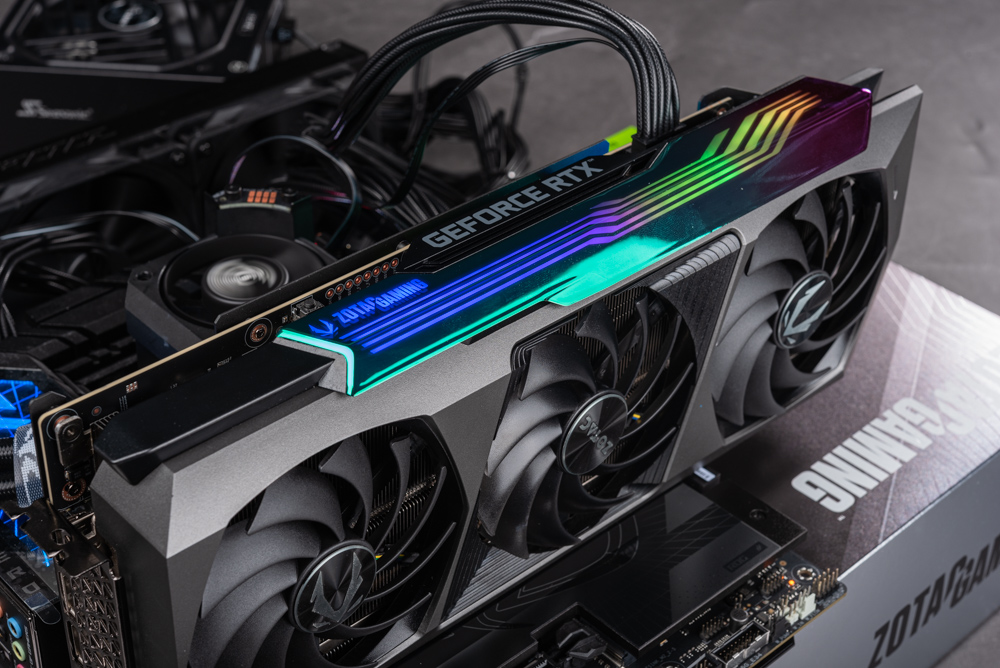
Introducing the powerful NVIDIA GeForce RTX 4070 Ti Super – a significant upgrade in the world of graphics cards. This model boasts a 10% increase in core count, ensuring smoother and faster performance. It’s equipped with a substantial 16GB of GDDR6X memory, catering to high-resolution gaming and demanding applications. The use of the advanced AD103 GPU enhances various units like TU and ROP, providing a notable boost in efficiency. Impressively, its performance closely rivals that of the RTX 4080, marking it as a top contender in the graphics card market. Specifically, gamers can expect a 13-14% improvement in 4K gaming performance compared to the RTX 4070 Ti. Priced at NT$ 29,490, the RTX 4070 Ti Super is set to redefine the standards for 4K gaming at 60 frames per second, taking the lead as the new benchmark in high-end gaming experiences.
Introducing the NVIDIA GeForce RTX 4070 Ti Super: The Ultimate 4K60 Gaming Experience
The NVIDIA GeForce RTX 4070 Ti Super is an exclusive model provided to all graphics card manufacturers, indicating that NVIDIA will not release a Founder’s Edition of this particular model. This SUPER variant stands out in the latest updates as it enhances both the ‘core’ and ‘memory’ aspects of the card. Moreover, the RTX 4070 Ti Super retains its pricing at USD 799, with a recommended retail price in Taiwan starting from NT$ 29,490.
In terms of upgrades, the RTX 4070 Ti Super boasts 66 SM units, 8448 CUDA cores, 264 Tensor cores, and 66 RT cores. It maintains the same clock speed and power consumption as its predecessors but sees improvements in TU and ROP units due to the core changes. It is equipped with 16GB of GDDR6X memory, solidifying its position as a new-generation entry-level card for 4K60 gaming.
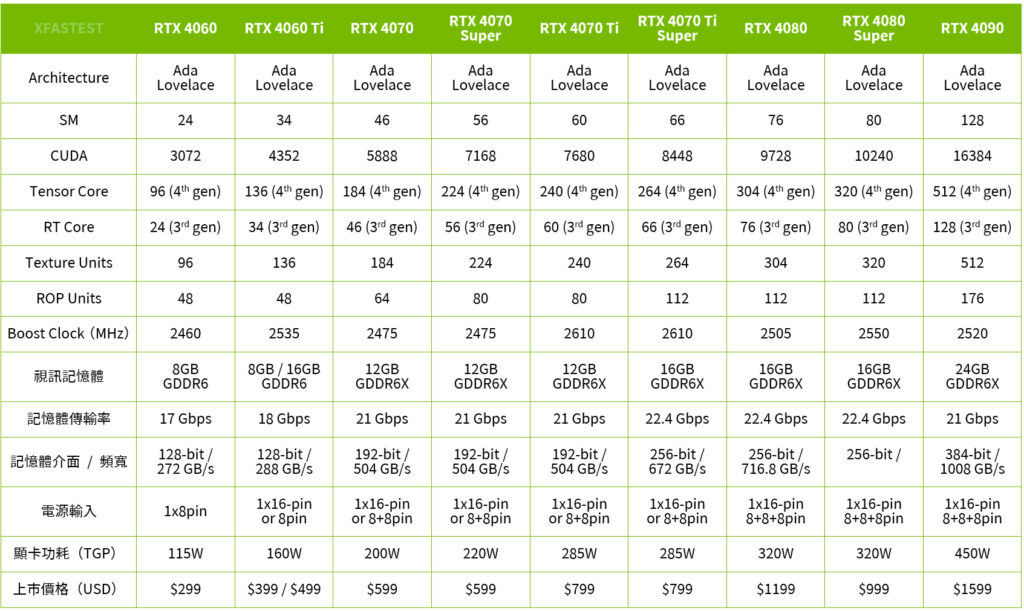
Unveil the power of NVIDIA’s RTX 4070 Ti Super, a formidable player in the RTX 40 series lineup. This cutting-edge graphics card is engineered with the Ada Lovelace architecture, featuring 66 SM units and a robust count of 8448 CUDA cores for unparalleled processing capabilities. It is equipped with 264 Tensor cores and 66 RT cores, optimized for advanced AI algorithms and real-time ray tracing. The card boasts 264 texture units and an impressive 112 ROP units for superior image quality and rendering precision. It runs at a boost clock of 2610 MHz and is paired with a high-capacity 16GB GDDR6X memory, clocking in at a swift 22.4 Gbps. With a 256-bit memory interface, it reaches a peak bandwidth of 672 GB/s. The RTX 4070 Ti Super maintains efficiency with a TGP of 285W and retains its competitive edge with a price tag of USD 799.
NVIDIA’s strategic move involves phasing out the RTX 4080 and RTX 4070 Ti in favor of the new Supermodels. The RTX 4080 stock is nearly depleted, indicating a swift transition to its Super variant, whereas the RTX 4070 Ti seems set to remain in the market for a bit longer.
In the RTX 40 series, the pinnacle of 4K gaming performance is undoubtedly represented by the RTX 4090 and the RTX 4080 Super. These cards deliver the ultimate gaming experience with unrivaled power and capabilities. For enthusiasts aiming for exceptional 1440p gaming, the lineup includes the RTX 4070 Ti Super, RTX 4070 Super, and the standard RTX 4070, all designed to cater to high-resolution gaming with advanced ray tracing and AI acceleration. The entry-level options, namely the RTX 4060 Ti and RTX 4060, are built to satisfy the gaming demands of a broader audience, ensuring that next-generation gaming features are accessible to all levels of gamers.
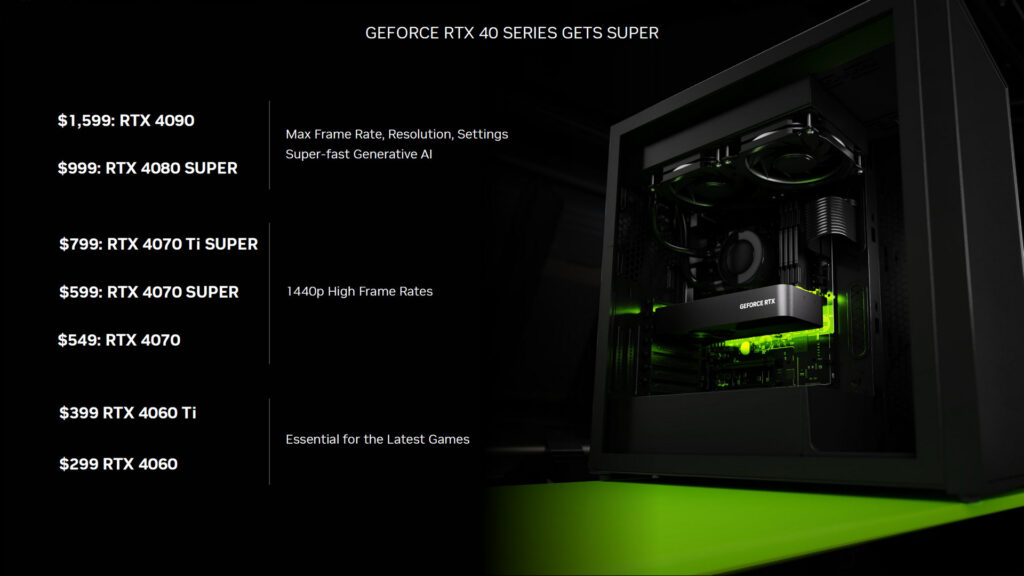
The NVIDIA RTX 40 Series Super lineup with their respective pricing. It presents a visually engaging marketing graphic, highlighting the key selling points of each model in the series:
- RTX 4090, priced at $1,599, is marketed as offering maximum frame rates, resolution, and settings for the ultimate gaming experience.
- RTX 4080 Super, available for $999, boasts super-fast generative AI capabilities, hinting at its advanced AI processing power.
- RTX 4070 Ti Super, set at $799, is positioned as the choice for 1440p gaming with high frame rates, indicating strong performance at this resolution.
- RTX 4070 Super, priced at $599, is also aimed at 1440p gaming enthusiasts.
- RTX 4070, available for $549, is part of the high-performance gaming segment.
- RTX 4060 Ti, with a price tag of $399, is denoted as essential for the latest games, suggesting it’s the entry-level option for modern gaming requirements.
- RTX 4060, the most affordable at $299, likely represents the baseline of next-gen gaming performance in the series.
ZOTAC’s RTX 4070 TI SUPER AMP HOLO Review: A Fusion of Power and Style
The test model of the RTX 4070 Ti Super graphics card is the ZOTAC GAMING GeForce RTX 4070 TI SUPER AMP HOLO, which features a cooling system derived from the previous generation’s flagship models. This card is designed with sleek, defined lines and an imposing geometric shape, complemented by a mirrored electroplated decorative panel on the side. Upon powering up the system, users are greeted with eye-catching, colorful RGB lighting effects, which also support external RGB expansion.
The RTX 4070 TI SUPER AMP HOLO is an overclocked (OC) card from the factory, with a GPU Boost clock set at a heightened 2640 MHz, pushing 30MHz over the top clock speed. It comes equipped with 16GB of GDDR6X memory, ensuring ample bandwidth for high-performance gaming and applications. The card is slightly larger in size, measuring 355.9mm x 149.7mm x 63.9mm, and it includes an RGB graphics card support bracket. This bracket ensures that the card remains horizontally aligned within the case, resisting the temptations of gravity and preventing any potential sagging due to its size and weight.
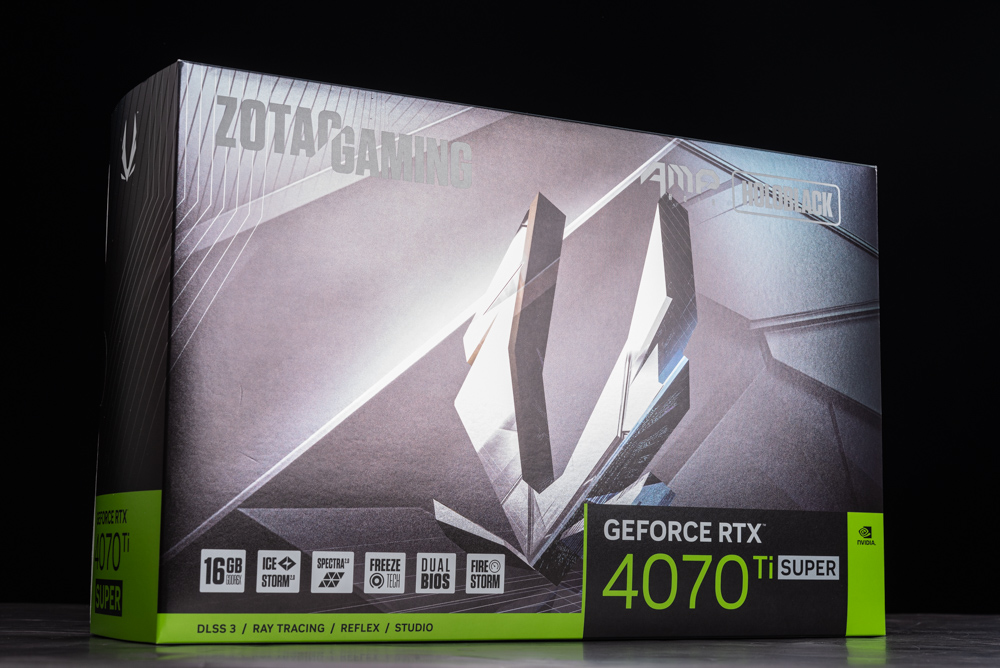
The retail packaging for the ZOTAC GAMING GeForce RTX 4070 Ti SUPER graphics card. The box design is sleek and modern, featuring a dynamic geometric pattern that reflects light differently from various angles, creating an eye-catching and premium visual effect. The packaging prominently displays the model name with the NVIDIA and ZOTAC GAMING branding, and it highlights key features such as 16GB GDDR6X memory, IceStorm cooling technology, SPECTRA RGB lighting, Dual BIOS capabilities, and support for FireStorm utility. It mentions NVIDIA technologies like DLSS 3, Ray Tracing, Reflex, and Studio, suggesting that the card is suitable for both high-fidelity gaming and professional content creation tasks. The design and information presented on the box are crafted to appeal to both gamers and professionals looking for high-performance graphics solutions.
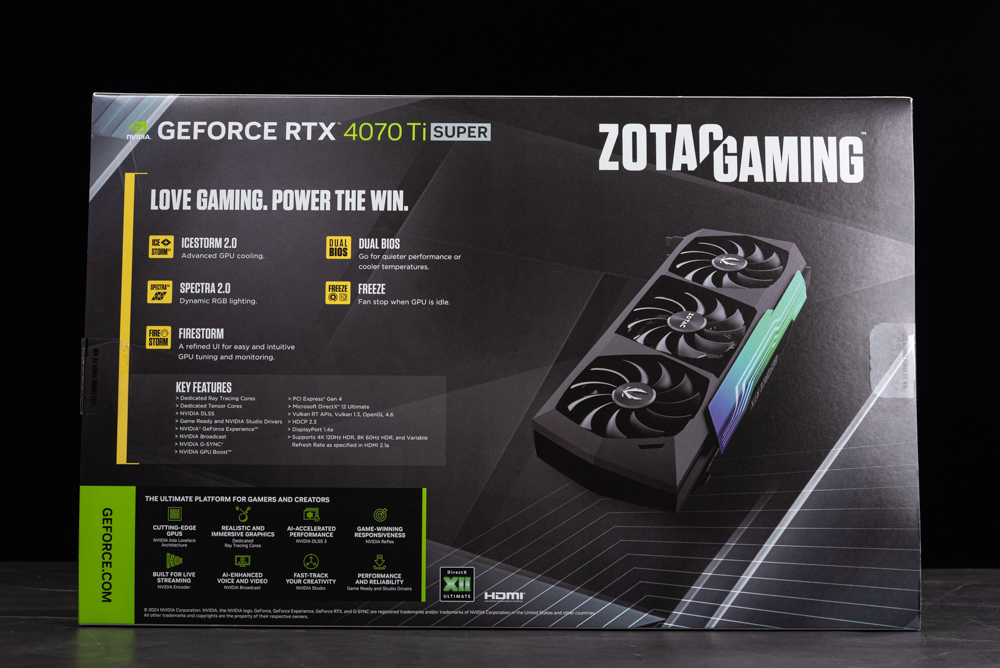
The ZOTAC GAMING GeForce RTX 4070 Ti SUPER encourages gamers to “Love Gaming. Power the Win.” It emphasizes advanced cooling with IceStorm 2.0 technology, ensuring optimized GPU temperatures for sustained performance. The dual BIOS feature offers a choice between quieter operation or enhanced performance, catering to different user preferences.
SPECTRA 2.0 lighting provides dynamic RGB illumination that enhances the aesthetic appeal of the gaming setup. The FREEZE technology is an intelligent fan control system that stops the fans when the GPU is idle, reducing noise and prolonging the fans’ lifespan. For tweaking and monitoring, the FireStorm utility offers a refined user interface that’s easy and intuitive to use.
The key features section likely highlights the cutting-edge capabilities of the card, such as the number of CUDA cores, highest clock speeds, and memory size, along with support for NVIDIA technologies like DLSS and Ray Tracing.
At the bottom, the packaging likely touts the card as “The Ultimate Platform for Gamers and Creators,” promoting cutting-edge features for gaming and content creation. It might also display various accolades or support for gaming-related technologies such as DirectX, Vulkan API, and hardware interfaces like HDMI, reinforcing the card’s suitability for high-performance gaming rigs and demanding creative workloads.
The combination of technical specifications and user-centric features on the packaging serves to inform potential buyers about the card’s performance and to entice them with its gaming and creative capabilities.
The ZOTAC GAMING RTX 4070 TI SUPER AMP HOLO leverages the HoloBlack cooling solution from the previous generation’s flagship models, exhibiting an impressively long 35.5 cm length that accommodates three fans for superior cooling efficiency. The card is designed with a blend of striking geometric shapes and sharp lines, creating a visually impactful aesthetic. Its side features a mirrored electroplated decorative panel that presents a sleek, dark holographic appearance when the card is not in use. Once the system is powered on, the graphics card comes to life with brilliant RGB lighting effects, adding a splash of color and dynamic visual interest to the user’s gaming setup. This design not only delivers in terms of functionality with its advanced cooling system but also stands out in terms of style, making it a centerpiece for any PC build.
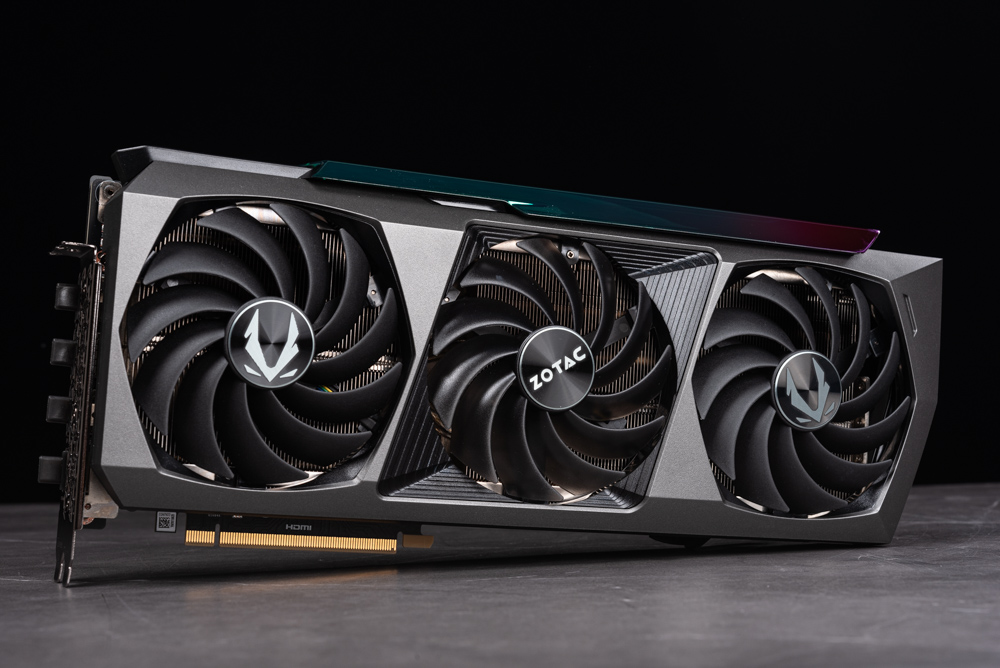
The ZOTAC GAMING RTX 4070 TI SUPER AMP HOLO graphics card, is a striking embodiment of the HoloBlack design ethos. The card features a bold geometric design that exudes a commanding presence. It has three large fans that dominate the front, each with the distinctive ZOTAC logo in the center, ensuring optimal airflow for cooling while also serving as a focal point of the design.
The side of the card displays the HoloBlack design’s signature – a holographic, color-shifting strip that gives it a unique and personalized aesthetic. This holographic element likely reflects different colors when viewed from various angles, contributing to the card’s dynamic and modern appearance.
The overall construction appears to be robust, with angular lines and a cohesive color scheme that speaks to the power and performance housed within. This design not only promises efficient cooling and performance but also delivers a visually appealing component that would stand out in any high-end PC gaming setup.
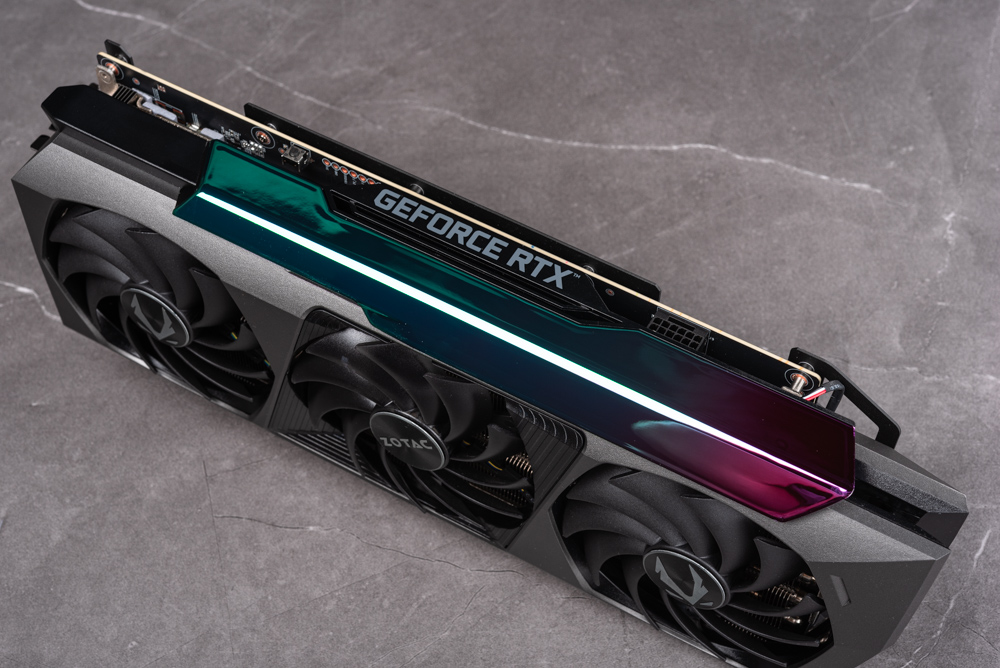
The ZOTAC GAMING GeForce RTX 4070 Ti SUPER AMP HOLO graphics card, showcases its elegant design features. The card is adorned with a mirrored electroplated decorative panel that stretches across the top edge, promising a mesmerizing display of RGB lighting effects when the device is powered on. The RGB lighting is likely programmable, allowing users to customize the look to match their system or personal style.
The “GEFORCE RTX” branding is illuminated on the side, providing a distinctive and high-end aesthetic that stands out, especially in a windowed PC case where visibility is key. This design feature not only enhances the visual appeal but also serves as a statement of the card’s high-performance capabilities. The combination of the mirrored finish and vibrant RGB lights creates a stunning visual impact, making the card not just a powerful component, but a centerpiece of any gaming rig.
The overall presentation of the card in the image suggests that it’s a product aimed at gamers and PC builders who value both performance and a visually striking design in their setups.
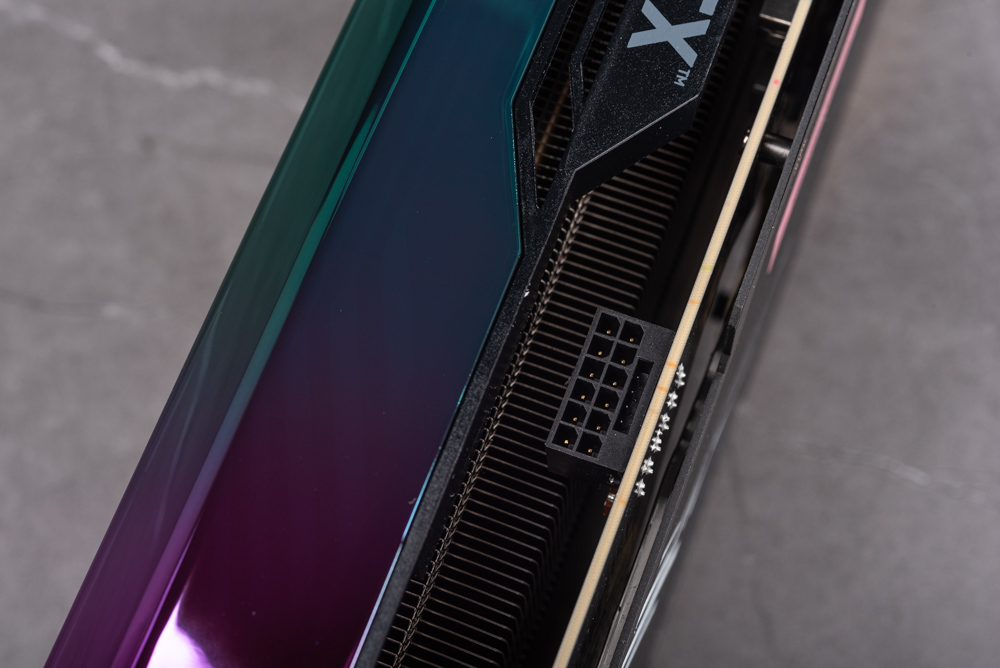
The power delivery aspect of the ZOTAC GAMING RTX 4070 TI SUPER AMP HOLO graphics card. It features a PCIe 12+4 pin power connector, which is a modern power delivery interface designed to meet the energy demands of high-performance graphics cards.
Given the 285W power consumption of the RTX 4070 TI SUPER AMP HOLO, it is recommended to pair this card with a power supply unit (PSU) that can provide at least 750W to ensure stable operation, especially under load or overclocking conditions. The inclusion of a PCIe 12+4 pin to triple PCIe 8-pin adapter cable as an accessory allows for compatibility with a wide range of existing power supplies that may not have the newer 12+4 pin connector.
This power configuration underscores the card’s status as a high-end option for gaming and demanding tasks, requiring a PSU that can reliably deliver the necessary power. Users can rest assured that the included adapter will facilitate seamless integration into their current systems without the immediate need for a PSU upgrade.
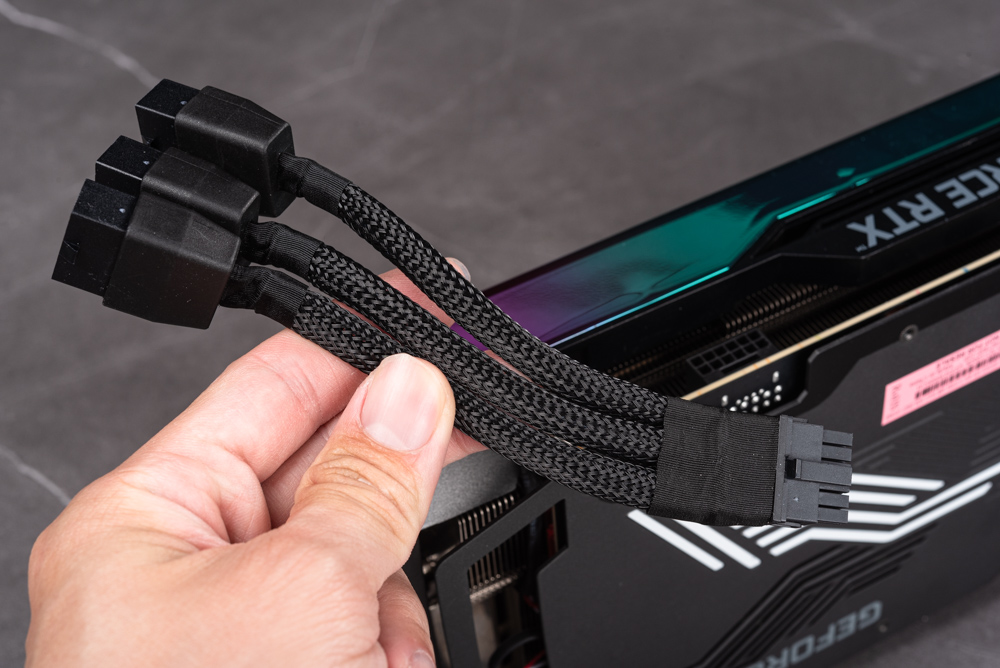
A hand holding a power cable adapter for a graphics card. This adapter is specifically a PCIe 12+4 pin to triple PCIe 8-pin converter, which is used to connect a power supply unit (PSU) with available 8-pin connectors to a graphics card that requires a 12+4 pin input.
This type of adapter is particularly useful for ensuring compatibility between newer graphics cards that use the 12+4 pin power connector and power supplies that may only have 8-pin connectors. It allows users to upgrade their graphics card without the need to purchase a new PSU with the specific 12+4 pin connector, assuming the PSU can deliver the required wattage.
The adapter itself appears to be well-constructed, with sleeved cables for improved durability and aesthetics. It’s a practical accessory that provides a convenient solution for PC builders and gamers looking to install the latest hardware into their existing systems.
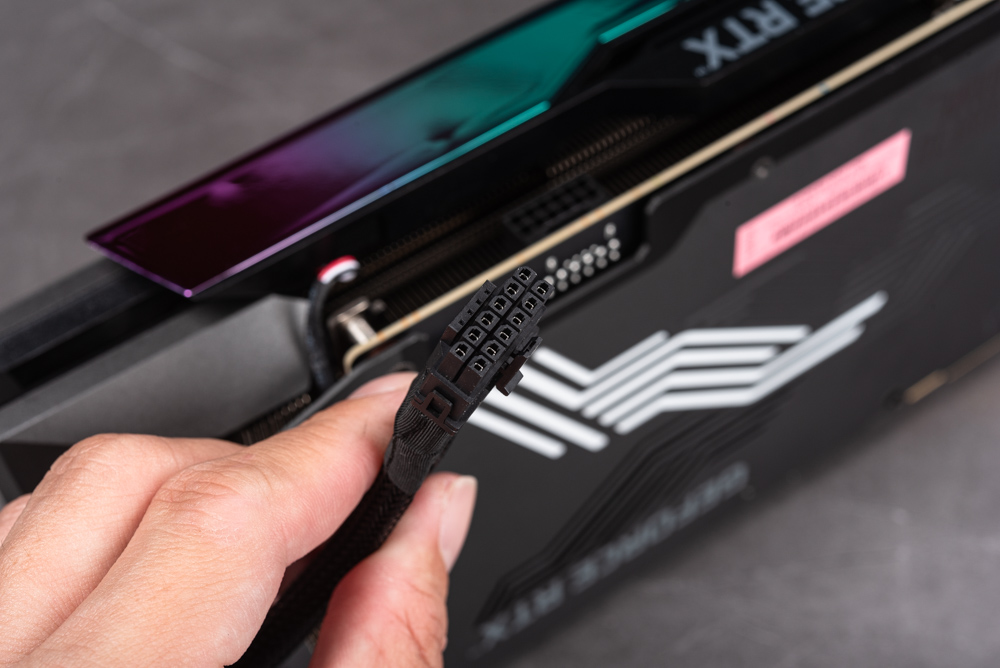
A close-up view of a hand holding the 12+4 pin end of a PCIe power connector. This end would connect to the corresponding input on the graphics card, providing the power necessary for its operation.
The 12+4 pin connector is part of the newer PCIe power standards, which are designed to handle the higher power requirements of advanced GPUs while also improving power efficiency and safety. This particular connector configuration can carry more power than the traditional 8-pin connectors, aligning with the demands of high-performance graphics cards like the RTX 4070 Ti Super.
The 12+4 pin connector is notable for its additional 4 pins, which may be used for grounding or for additional power, depending on the specifications of the PSU and the graphics card. The sleeved cable and secure connection, it ensures that the graphics card receives a stable and reliable power supply, which is crucial for maintaining the performance and longevity of the component.
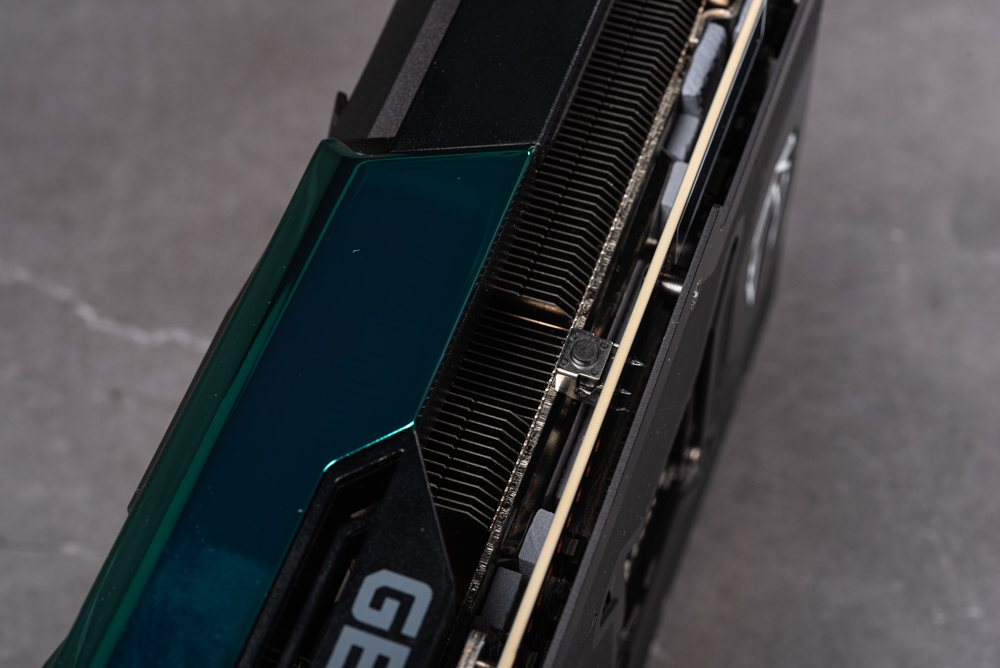
A close-up of a feature on the side of the ZOTAC GAMING GeForce RTX 4070 Ti SUPER AMP HOLO graphics card. It shows a small button or switch, which is typically used to change between dual BIOS settings. This allows users to switch between two different firmware settings: one might be tuned for performance while the other might focus on quieter operation, providing flexibility depending on the user’s needs or preferences.
The image seems to mention a red RGB expansion connector located near the front of the card. This connector can be utilized with the included cable to convert to an ARGB 3-pin connection, which is standard for many RGB lighting systems. By connecting this to an RGB-supporting graphics card brace or other compatible devices, users can synchronize the RGB lighting effects across their system components, creating a cohesive and visually appealing aesthetic inside their PC case.
The dual BIOS feature, combined with the expandable RGB options, underlines the card’s versatility and customization options, catering both to enthusiasts who value performance tweaks and to those who appreciate a personalized visual experience.
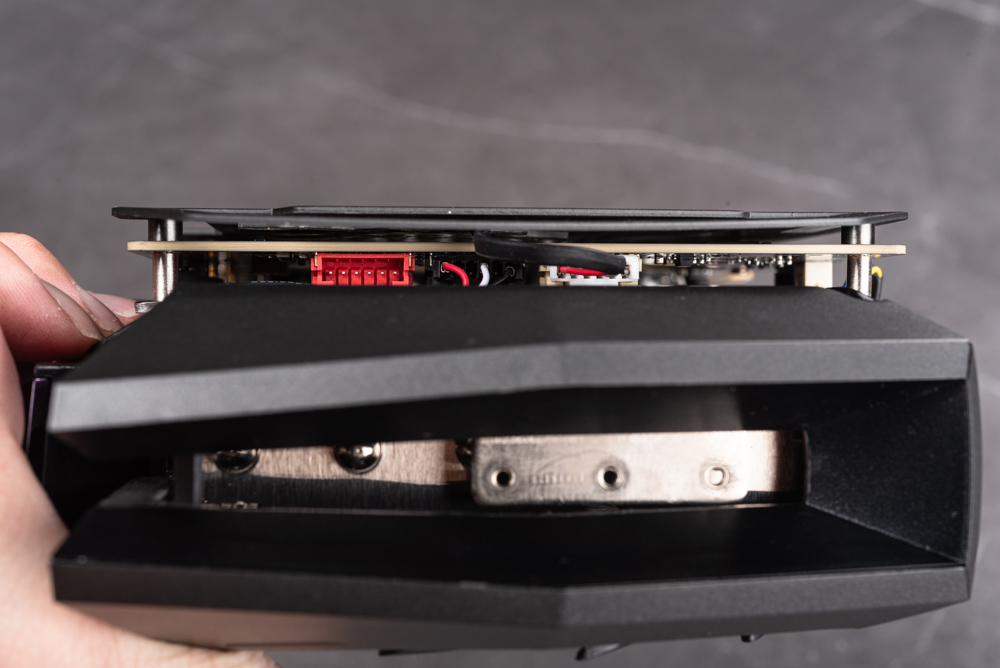
A close-up view of an RGB expansion socket on a graphics card, likely the ZOTAC GAMING GeForce RTX 4070 Ti SUPER AMP HOLO. This RGB connector is designed for attaching additional RGB lighting accessories, such as an RGB-lit support bracket or other compatible RGB devices, to the graphics card.
This RGB expansion socket is typically used to allow the graphics card’s lighting to be synchronized with other components in the system that support RGB functionality. With the use of compatible software, users can manage and customize the RGB lighting effects to match their personal style or to create a specific ambiance within their PC case.
The visible RGB connector, often a small 4-pin (sometimes 3-pin for ARGB) connector, is an increasingly common feature on modern high-end graphics cards, emphasizing the trend towards personalization in PC builds. It caters to the aesthetic preferences of gamers and PC enthusiasts who enjoy a customizable and visually coordinated setup.
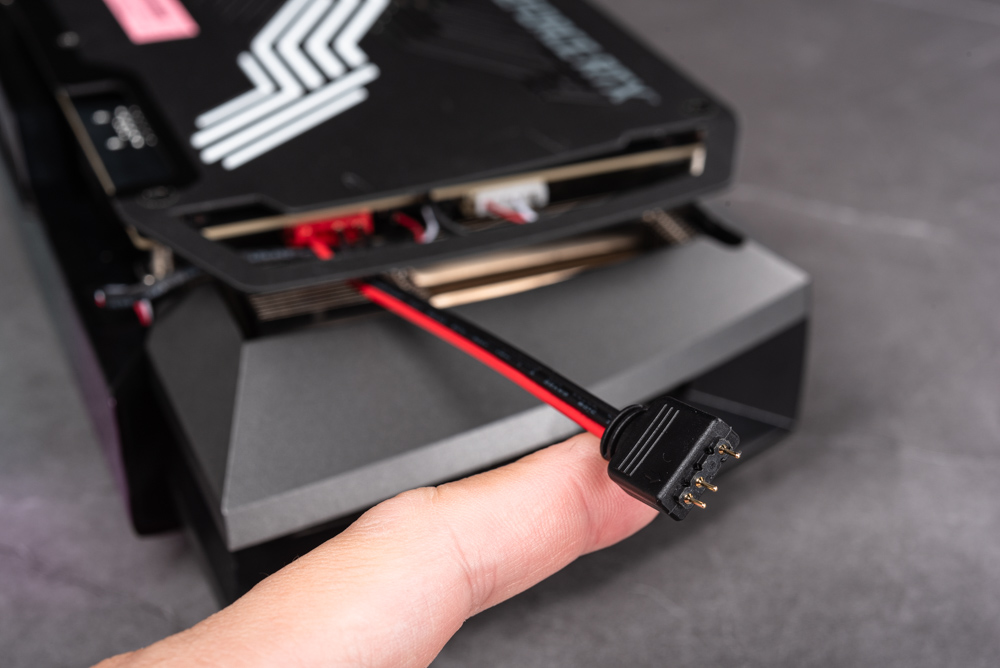
A hand holding an ARGB (Addressable RGB) 3-pin connector, which is commonly used in PC components and accessories to connect to an ARGB lighting system. The 3-pin design usually indicates that each LED can be controlled individually, allowing for more complex lighting effects compared to non-addressable RGB, which lights all LEDs the same color at once.
This connector would typically plug into an ARGB header on a motherboard or an ARGB controller, enabling users to customize lighting profiles through software. The individual control over the LEDs means users can enjoy a range of dynamic lighting effects like color waves, breathing, and other patterns that can be synced across all connected ARGB devices for a cohesive and personalized look inside the PC case.
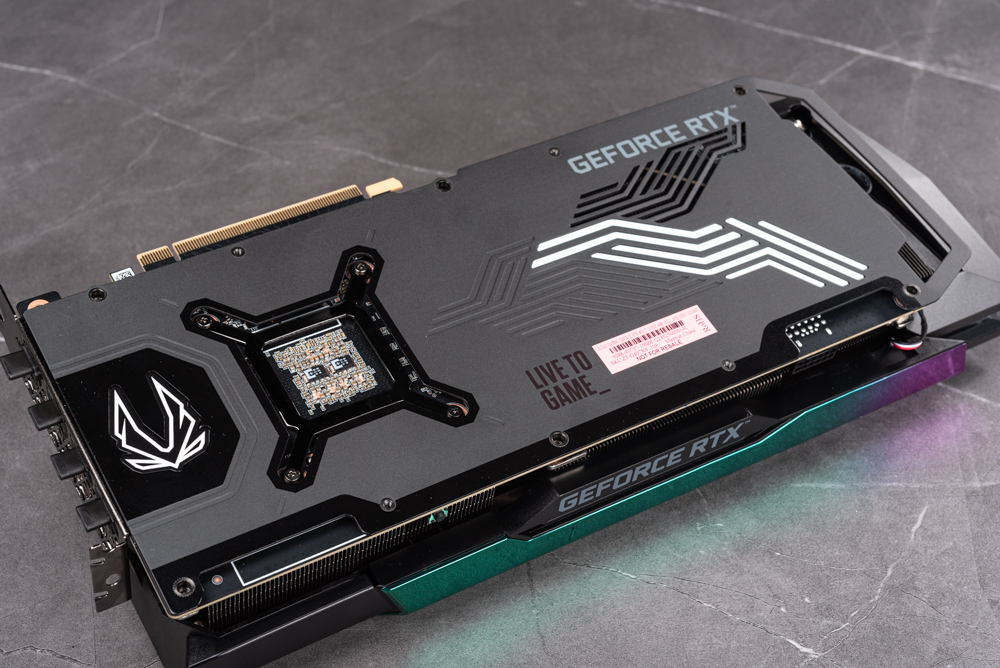
The backplate of a ZOTAC GAMING GeForce RTX 4070 Ti SUPER AMP HOLO graphics card. The metal backplate features an intricate design with the ZOTAC GAMING logo and stylish patterns that contribute to the overall aesthetics of the card. The phrase “LIVE TO GAME” is also prominently displayed, resonating with the gaming community’s passion.
The backplate is not just for looks; it provides structural rigidity to the card, helping to prevent PCB bending over time due to the weight of the card. It also aids in heat dissipation, contributing to the overall thermal management of the device.
An RGB lighting effect is visible along the edge of the card, providing a subtle but attractive glow that enhances the visual appeal of the card when installed in a PC case with a transparent side panel. This RGB lighting can typically be customized through software, allowing users to match the color and lighting effects with their system’s theme or personal preference. The use of RGB lighting on the backplate is a testament to the attention to detail and the emphasis on combining performance with high-end design aesthetics.
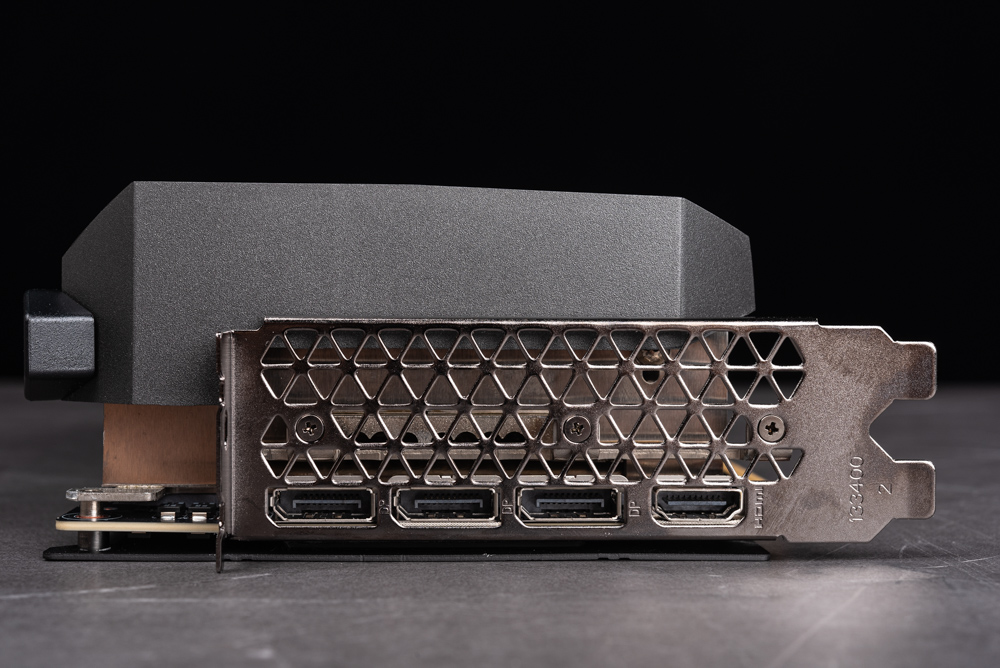
The I/O (Input/Output) bracket of what seems to be a high-end graphics card, likely the ZOTAC GAMING GeForce RTX 4070 Ti SUPER AMP HOLO. The I/O bracket shows a variety of ports that are used to connect the graphics card to display monitors. There are three DisplayPort 1.4a outputs and one HDMI 2.1a output, allowing for a multi-monitor setup with up to four external displays.
The DisplayPort 1.4a connectors are capable of supporting high refresh rates and resolutions, making them suitable for gaming monitors that require fast data transfer for smooth gameplay. The HDMI 2.1a port is the latest version of HDMI, supporting higher resolutions and refresh rates, as well as features such as dynamic HDR, making it ideal for both gaming and home entertainment setups.
The bracket itself has a robust and rugged design, with a pattern that likely aids in ventilation while also contributing to the overall aesthetic of the card. The presence of multiple high-specification display outputs indicates the card’s target audience of gamers and professionals who require a powerful multi-display environment.
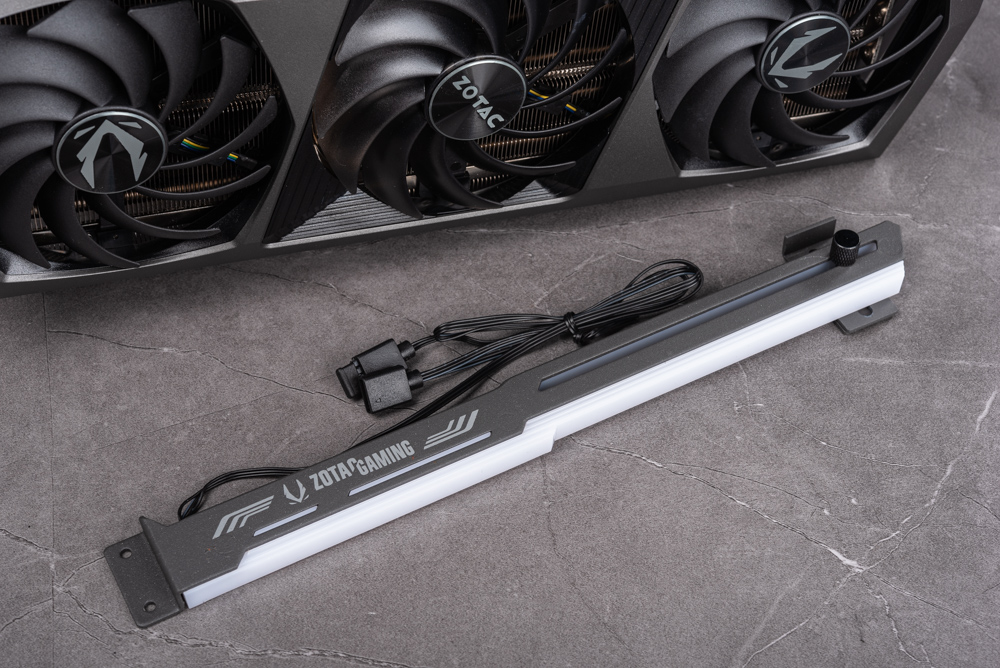
An RGB graphics card support bracket is included as an accessory, typically used to prevent the sagging of heavy graphics cards. This bracket appears to be part of the ZOTAC GAMING series, as indicated by the branding and features RGB lighting, which can be customized to match the aesthetics of the user’s gaming setup.
The support bracket is designed to be mounted inside a PC case and provides physical support to the underside of the graphics card, ensuring it remains level and secure within the PCIe slot. This is especially important for high-end graphics cards with large coolers and substantial weight, which can sometimes lead to bending or stress on the motherboard over time.
The RGB lighting on the bracket can be connected to the motherboard or directly to the graphics card via an RGB header, allowing for synchronized lighting effects with the rest of the system’s RGB components. The inclusion of such a bracket demonstrates consideration for both the structural integrity of the PC build and the desire for visual customization that is popular among gaming PC enthusiasts.
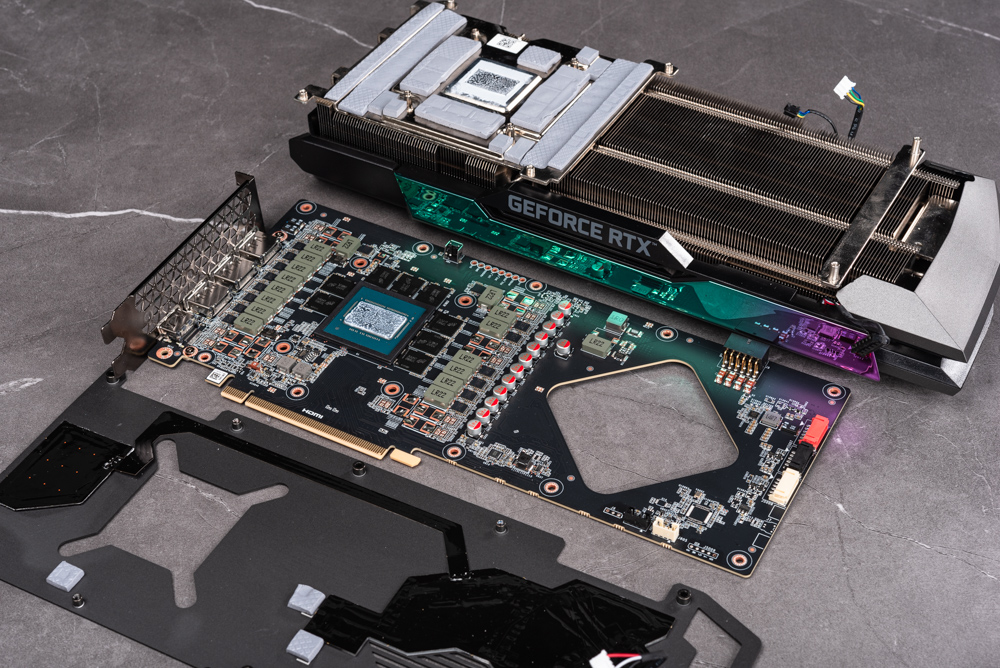
A disassembled ZOTAC GAMING GeForce RTX 4070 Ti SUPER AMP HOLO graphics card. The photo provides a detailed look at the internals, highlighting the PCB (Printed Circuit Board), the GPU (Graphics Processing Unit), the VRAM (Video Random Access Memory), and various other components like capacitors and VRMs (Voltage Regulator Modules).
The metal backplate and the heatsink clamp the PCB securely, ensuring good thermal contact for heat dissipation. The heatsink is attached to the PCB with screws, and it extends to the rear, where it is fixed onto the PCIe bracket, providing additional support.
Given the length and weight of this high-end card, it is noted that horizontal installation within a PC case would require the use of a support bracket to prevent the card from warping or bending over time. This is a common recommendation for larger, heavier graphics cards to maintain structural integrity and prevent damage to the PCIe slot on the motherboard caused by the card’s weight.
The disassembly reveals the intricate design and engineering that goes into producing a high-performance graphics card capable of handling demanding tasks such as gaming, video editing, and 3D rendering. It also underscores the importance of proper support and installation to ensure the longevity and performance of such hardware.
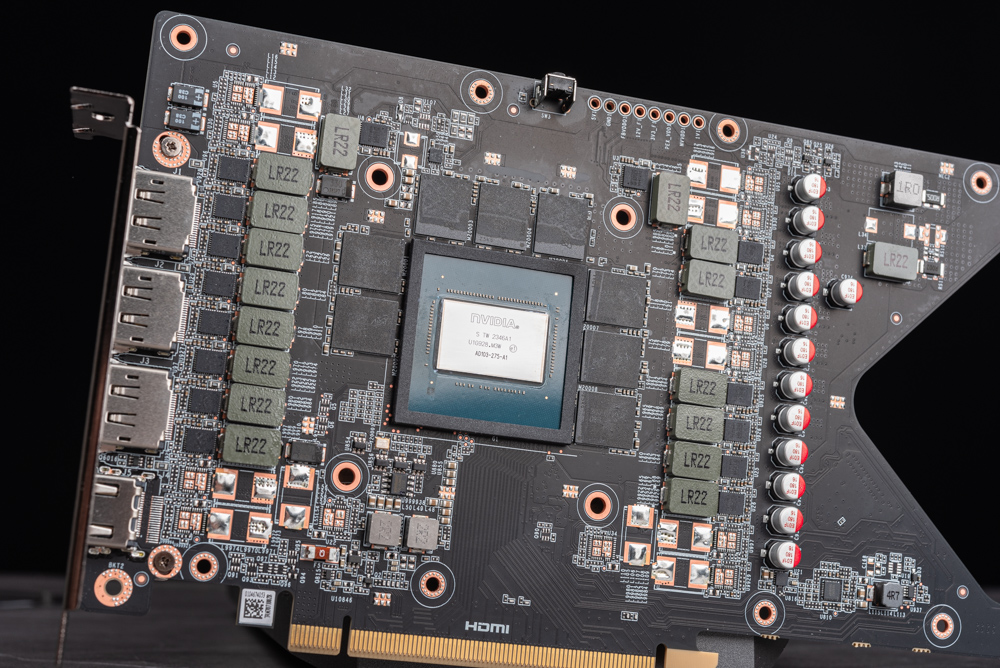
A close-up view of the PCB of a high-performance graphics card, which appears to be the ZOTAC GAMING GeForce RTX 4070 Ti SUPER. Central to the board is the NVIDIA AD103-275-A1 GPU core, which is the heart of the card’s processing power.
Surrounding the GPU are eight GDDR6X memory modules that collectively provide a total of 16GB of VRAM, offering ample memory capacity for demanding games and applications that require high-resolution textures and fast memory bandwidth.
The front of the PCB features large cut-outs for heat dissipation, a design that aids in cooling the GPU and memory modules. However, as noted in the description, because the heatsink and backplate design are carried over from a previous generation, they may not facilitate the passage of air as effectively as a design optimized specifically for this GPU model would. This can be important for thermal management, especially under heavy loads where efficient cooling is crucial to maintain performance and longevity.
The layout of the capacitors and VRMs along the edges of the GPU core indicates a robust power delivery system designed to ensure a stable power supply to the GPU for consistent performance. This view of the PCB reveals the complexity and precision engineering that goes into creating a modern graphics card capable of delivering top-tier gaming and computing experiences.
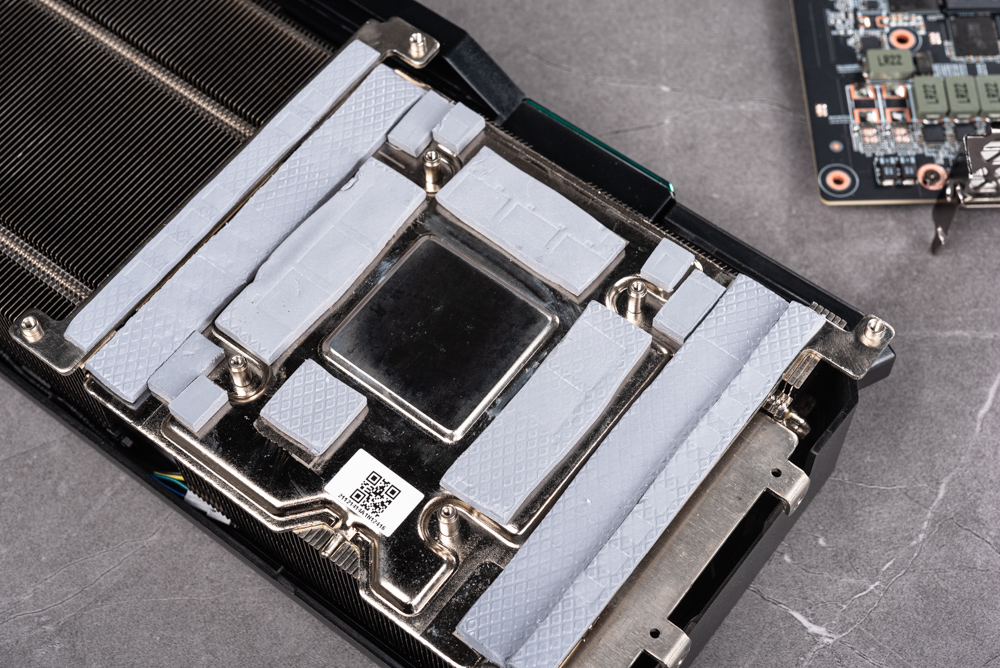
The heatsink of what seems to be a high-end graphics card, possibly the ZOTAC GAMING GeForce RTX 4070 Ti SUPER AMP HOLO. The heatsink is designed with a large nickel-plated copper base that makes direct contact with the GPU for efficient heat transfer. It also extends over the VRAM and VRM areas, which are critical for memory and power delivery cooling, respectively.
The thermal solution is enhanced with numerous densely packed fins that maximize the surface area for heat dissipation. These fins are connected to the copper base via heat pipes that spread the thermal energy away from the hotspots (like the GPU core) across the entire heatsink. This design is indicative of a sophisticated cooling system that is necessary to handle the heat output of powerful GPUs.
Due to the extensive cooling apparatus, the card requires 3.5 slots’ worth of space in a PC case, which is a considerable amount and may impact the compatibility with smaller cases or setups with limited space. The requirement for such a large space is a direct result of the need for effective cooling to maintain optimal performance and reliability, especially under heavy loads or during overclocking sessions.
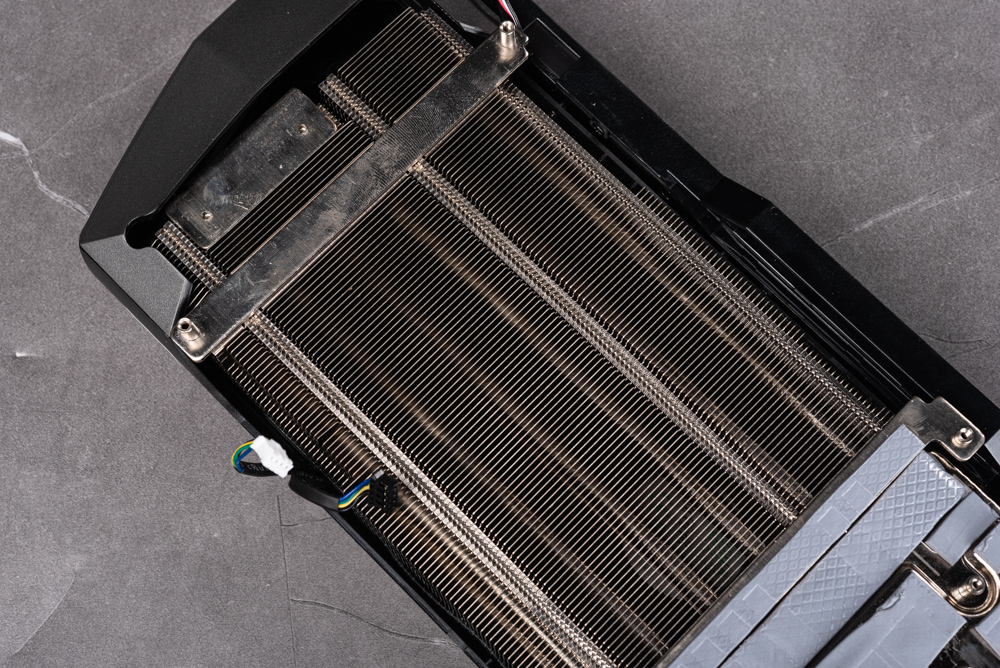
A detailed view of a graphics card heatsink. This component is essential for dissipating the heat generated by the GPU and other onboard components to maintain optimal performance and prevent overheating.
The heatsink is comprised of a dense array of thin metal fins that increase the surface area available for heat exchange with the surrounding air. Between these fins are heat pipes, which are likely made of copper due to its high thermal conductivity. These pipes transfer heat from the GPU’s core to the fins, where it can be carried away by the airflow within the PC case, typically driven by the card’s fans or the case’s cooling system.
The photo suggests a substantial cooling solution, indicating that the graphics card is designed to handle demanding workloads such as gaming, video rendering, or AI computations, which can generate significant amounts of heat. It’s also an indication of the card’s potential for overclocking, where additional thermal headroom is necessary to handle increased power consumption and heat output.
The design and size of the heatsink are indicative of a high-end or performance-oriented graphics card, where effective cooling is crucial for maintaining the reliability and longevity of the device.
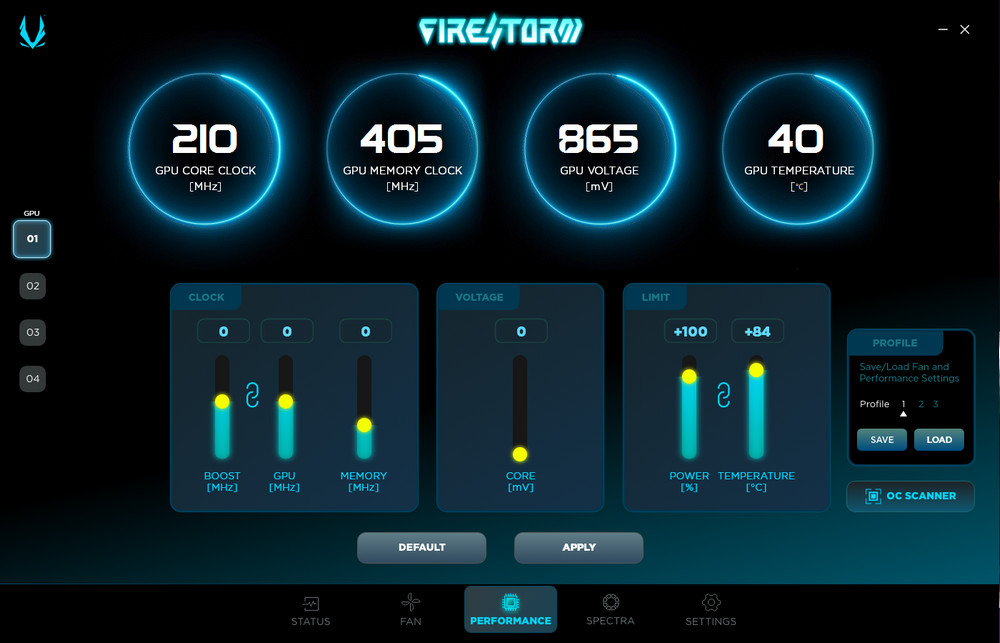
The FireStorm utility software by Zotac is a tool used for tuning the performance settings of Zotac graphics cards. The FireStorm interface displayed appears to be user-friendly and intuitive, designed to allow users to adjust important parameters such as GPU core clock, GPU memory clock, and GPU voltage.
In the performance tab, users can tweak the clock speeds of the GPU and memory, as well as the core voltage, allowing for overclocking to boost performance beyond factory settings. There’s also the ability to set power and temperature limits, which can be essential for maintaining the balance between performance and hardware longevity.
The fan control functionality offers both an automatic mode, which adjusts the fan speed based on temperature, and a manual mode, where users can define their own fan speed curves or set fixed speeds to optimize cooling and noise levels according to their preferences.
The status tab provides real-time monitoring of various card statistics, including utilization, clock speeds, and temperatures, helping users keep an eye on the health and performance of their graphics card.
The Spectra tab allows users to customize the RGB lighting effects and modes on their graphics card, providing a personalized aesthetic that can sync with the rest of their PC components or gaming environment.
The FireStorm utility gives users comprehensive control over their graphics card’s performance and appearance, making it a valuable tool for enthusiasts looking to optimize their gaming or creative workflows.
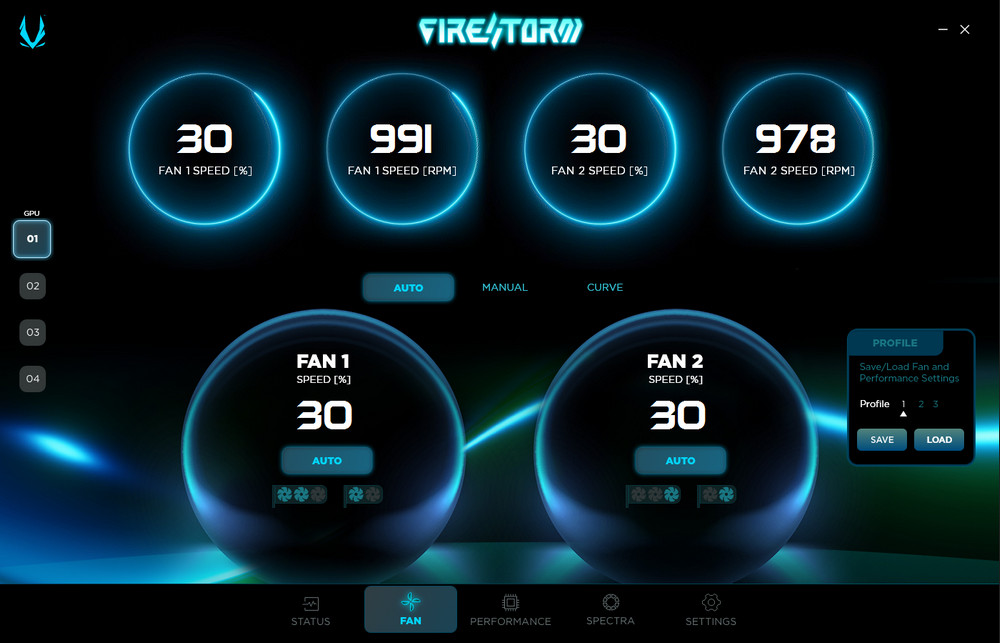
The fan control interface of the FireStorm utility software is designed for managing the cooling system of Zotac graphics cards. This particular screen focuses on the customization of the fan speeds.
The interface shows two sets of readings for each fan: the percentage speed (Fan 1 Speed [%] and Fan 2 Speed [%]) and the actual RPM (Revolutions Per Minute). Both fans are currently set to run at 30% of their maximum speed, which corresponds to 991 RPM for Fan 1 and 978 RPM for Fan 2.
Users can choose between automatic or manual control modes for the fans. In automatic mode, the fan speed dynamically adjusts based on the GPU’s temperature to maintain optimal cooling efficiency. In manual mode, users can set a fixed fan speed or create a custom fan curve that dictates how fan speed should respond to temperature changes.
The interface also offers the ability to save and load custom fan and performance profiles. This allows users to switch between different settings depending on the task, whether it’s gaming, rendering, or any other GPU-intensive operation, without having to readjust the settings each time.
The design of the FireStorm utility is user-centric, with an emphasis on simplicity and functionality, making it accessible for users of all levels of expertise to optimize the cooling performance of their Zotac graphics cards.
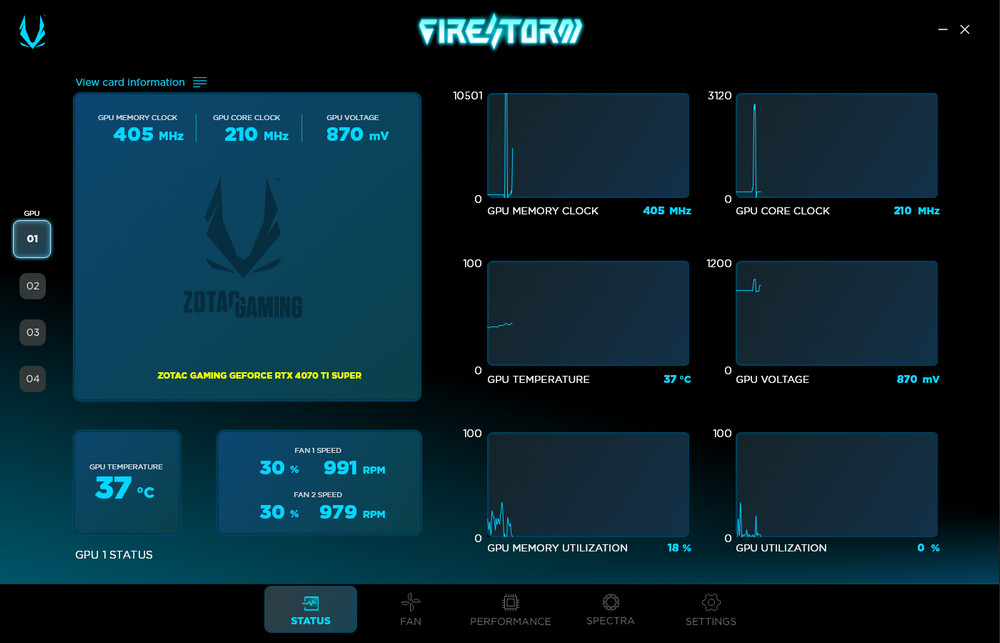
The status information panel of the FireStorm software utility. This panel provides real-time monitoring data for the Zotac Gaming GeForce RTX 4070 Ti SUPER graphics card. The following metrics are visible:
- GPU Memory Clock: 405 MHz
- GPU Core Clock: 210 MHz
- GPU Voltage: 870 mV
- GPU Temperature: 37°C
- Fan 1 Speed: 30% (991 RPM)
- Fan 2 Speed: 30% (979 RPM)
- GPU Memory Utilization: 18%
- GPU Utilization: 0%
This information is crucial for users who want to monitor the performance and health of their graphics card. The GPU memory and core clocks are indicative of the operational frequencies of the memory and the GPU. The voltage reading gives an insight into the power being supplied to the GPU, which is particularly useful for overclocking scenarios.
The GPU temperature is an important metric for gauging the effectiveness of the cooling solution. The fan speed, in percentage and RPM, shows how the cooling system is responding to the temperature of the GPU.
The utilization percentages provide an overview of how much of the GPU’s resources are being used at the time. Low utilization might suggest idle or low-demand conditions, while high utilization indicates that the GPU is being leveraged for intensive tasks.
This interface is designed to offer a snapshot of the GPU’s performance metrics, allowing users to make informed decisions about settings adjustments, troubleshoot potential issues, and optimize their gaming or content creation experience.
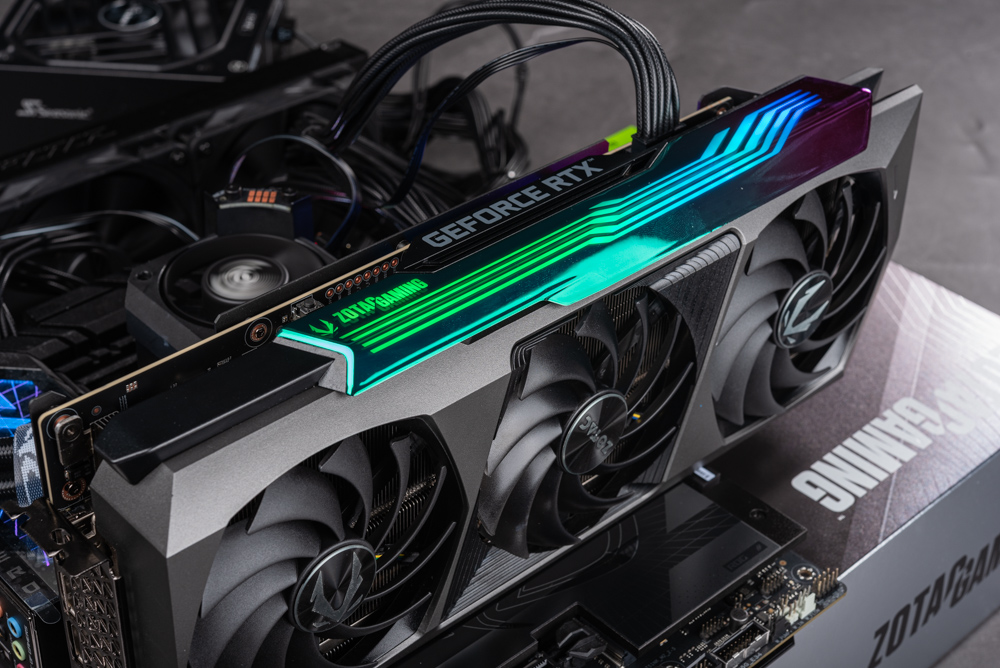
A fully assembled ZOTAC GAMING GeForce RTX 4070 Ti SUPER AMP HOLO graphics card with its RGB lighting effects activated. The RGB lighting illuminates the card’s branding and adds visual flair to the overall design. It appears to feature a spectrum of colors that likely can be customized through Zotac’s FireStorm software or a similar RGB control utility.
The lighting strip runs along the top edge of the card, which is typically the most visible area when installed in a standard ATX case with a transparent side panel. This design choice not only enhances the aesthetics of the card but also allows users to personalize their gaming setup with dynamic lighting that complements the rest of their system.
The presence of RGB lighting on high-end graphics cards has become a standard feature for many manufacturers, appealing to gamers and PC enthusiasts who value both performance and the ability to customize the look of their PC components.
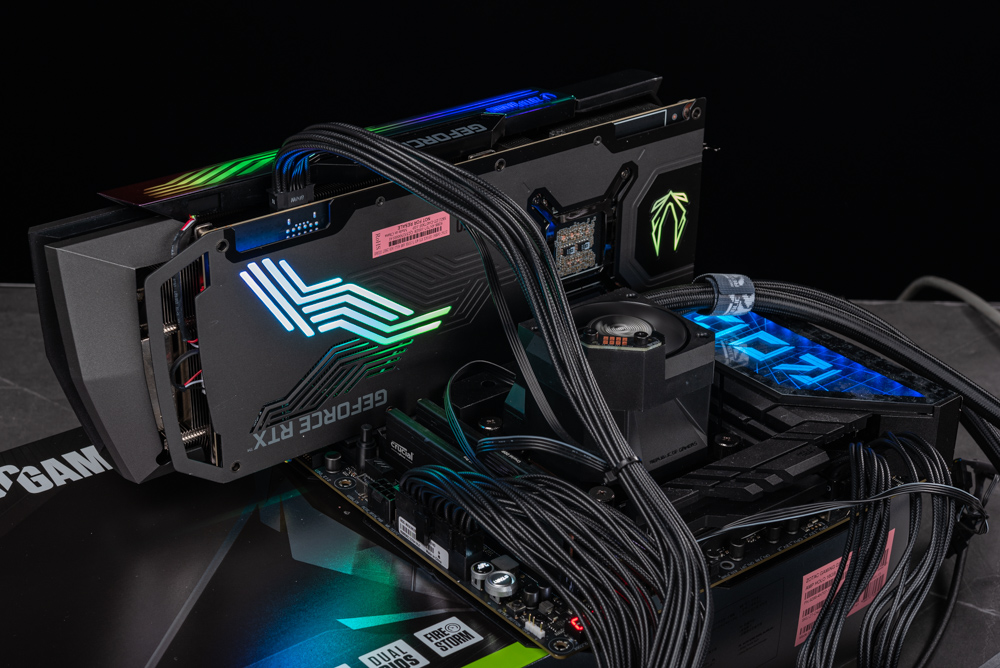
A ZOTAC GAMING GeForce RTX 4070 Ti SUPER AMP HOLO graphics card installed in a PC system, showcasing the vibrant RGB lighting effects. The lighting adds a dynamic and customizable element to the visual presentation of the PC build.
These RGB accents are prominent on both the graphics card and what seems to be an RGB-lit support bracket below it, enhancing the cohesion of the system’s aesthetic. The system includes a motherboard and other components, all connected with neatly managed cabling, which is likely part of a high-performance gaming or workstation setup.
The RGB lighting on the graphics card is integrated into the design, illuminating the brand’s logo and the patterned lines on the side of the card that face outwards when mounted in a typical PC case. This allows the card to contribute to the overall look and feel of the system, which can be customized to the user’s preference through software, synchronizing colors and effects with other components for a cohesive look.
The visual effect of the RGB lighting in a PC build is a popular trend among gamers and enthusiasts who take pride in the appearance of their setups, often matching the lighting to specific themes or color schemes.
Comprehensive Review: RTX 4070 Ti Super’s Outstanding Performance in DaVinci Resolve, Blender, and More
For the performance testing, the setup includes a suite of professional and gaming benchmarks to evaluate the capabilities of NVIDIA’s latest RTX 4070 series, including the RTX 4070, RTX 4070 Super, RTX 4070 Ti, and RTX 4080 graphics cards. The tests are conducted using a high-end system configuration, ensuring that the CPU and other components do not bottleneck the GPU’s performance.
Here’s a summary of the test setup and benchmarks:
Test Setup:
- CPU: Intel Core i9-14900K
- Motherboard: ASUS ROG MAXIMUS Z790 DARK HERO
- Memory: Crucial Pro DDR5 5600 32GBx2
- Graphics Cards: RTX 4070 Ti Super, RTX 4070 Super, RTX 4070 Ti, RTX 4070, RTX 4080
- System Drive: Solidigm P44 Pro 1TB PCIe 4.0 SSD
- Cooler: ASUS ROG RYUJIN III 360
- PSU: Seasonic FOCUS GX (ATX3.0) 750W
- Operating System: Windows 11 Pro 21H2 64bit with Resizable BAR On
- Driver Version: NVIDIA 546.52
Benchmarks:
- DaVinci Resolve 18: Professional video editing and color grading software
- Blender: 3D modeling and rendering software for creative tests
- Gaming: Testing at resolutions of 1440p and 2160p (4K) with maximum graphics settings across esports titles, AAA games, and titles with ray tracing enabled
- DLSS 3 Tests: Assessing the performance impact of NVIDIA’s Deep Learning Super Sampling technology
The RTX 4070 Ti Super is powered by a 5nm AD103 GPU, featuring 8,448 CUDA cores for rendering, and comes with 16,384 MB of GDDR6 memory from Micron. The GPU has a base clock of 2340 MHz and a boost clock of 2640 MHz.
It’s noted that GPU-Z, a tool for monitoring and diagnosing GPUs, does not yet support viewing information for the NVIDIA GeForce RTX 4070 Ti Super, which suggests this is a very recent release at the time of testing.
This comprehensive testing approach provides valuable data for gamers and professionals looking to understand the performance characteristics of these GPUs, especially with their suitability for high-end gaming and content creation tasks. The detailed system specifications also serve as a guide for those looking to build or upgrade their system with one of these graphics cards.
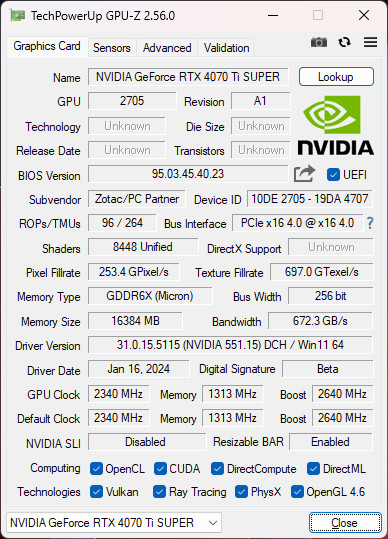
A screenshot of the GPU-Z software interface displaying detailed information about the NVIDIA GeForce RTX 4070 Ti SUPER graphics card. GPU-Z is a utility designed to give users information about their video card and GPU.
Here are the key specifications and information presented:
- Graphics Card: NVIDIA GeForce RTX 4070 Ti SUPER
- GPU Code Name: 2705 with Revision A1
- Technology, Die Size, Transistors: These fields are unknown, which is common with newer or unsupported hardware in GPU-Z until the database is updated.
- Release Date, BIOS Version: Not specified clearly in the image.
- Subvendor: Zotac/PC Partner
- Device ID: 10DE 2705 – 19DA 4707
- ROPs/TMUs: 96 ROPs / 284 TMUs
- Bus Interface: PCIe x16 4.0 @ x16 4.0
- Shaders (CUDA Cores): 8448
- DirectX Support: DirectX 12
- Pixel Fillrate: 253.4 GPixels/s
- Texture Fillrate: 697.0 GTexels/s
- Memory Type: GDDR6X (Micron)
- Bus Width: 256-bit
- Memory Size: 16384 MB
- Bandwidth: 672.3 GB/s
- Driver Version: 31.0.15.1515 (NVIDIA 515.15) / Win11 64
- GPU Clock: 2340 MHz (default and boost)
- Memory Clock: 1313 MHz (5265 MHz effective)
- NVIDIA SLI: Disabled
- Resizable BAR: Enabled
- Supported Technologies: CUDA, DirectCompute, Vulkan, Ray Tracing, PhysX, OpenGL 4.6
The screenshot also shows the GPU and memory clocks, which indicate the card’s performance potential. The enabled Resizable BAR feature can offer improved performance in certain scenarios by allowing the CPU to access the entire GPU memory simultaneously.
The inclusion of advanced technologies like Ray Tracing and PhysX highlights the card’s capabilities for rendering realistic lighting effects and physics simulations in games and other applications. This information can be particularly useful for consumers or tech enthusiasts looking to compare specifications or verify the capabilities of their graphics hardware.
The performance results of the NVIDIA GeForce RTX 4070 Ti Super in the UL Procyon Photo Editing Benchmark, a tool used to assess the performance of systems in photo editing tasks with Adobe Photoshop and Lightroom Classic.
In this benchmark, the RTX 4070 Ti Super scored:
- Overall: 9421 points
- Image Retouching: 9874 points
- Batch Processing: 8990 points
The Image Retouching test involves using Photoshop for detailed photo retouching and measures the time taken for each step. The Batch Processing test assesses the performance in Lightroom when making adjustments and exporting a large number of photos in a batch operation.
The RTX 4070 Ti Super’s performance shows approximately a 4% improvement over the RTX 4070 Ti, suggesting incremental advancements in efficiency or processing power that benefit photo editing workloads. The card’s performance is comparable to the RTX 4080, trailing by a minor 2%. This small margin indicates that the RTX 4070 Ti Super is very close to the higher-tier card in terms of photo editing efficiency, offering nearly equivalent performance for potentially less cost, making it an attractive option for content creators who rely on GPU acceleration in their photo editing workflows.
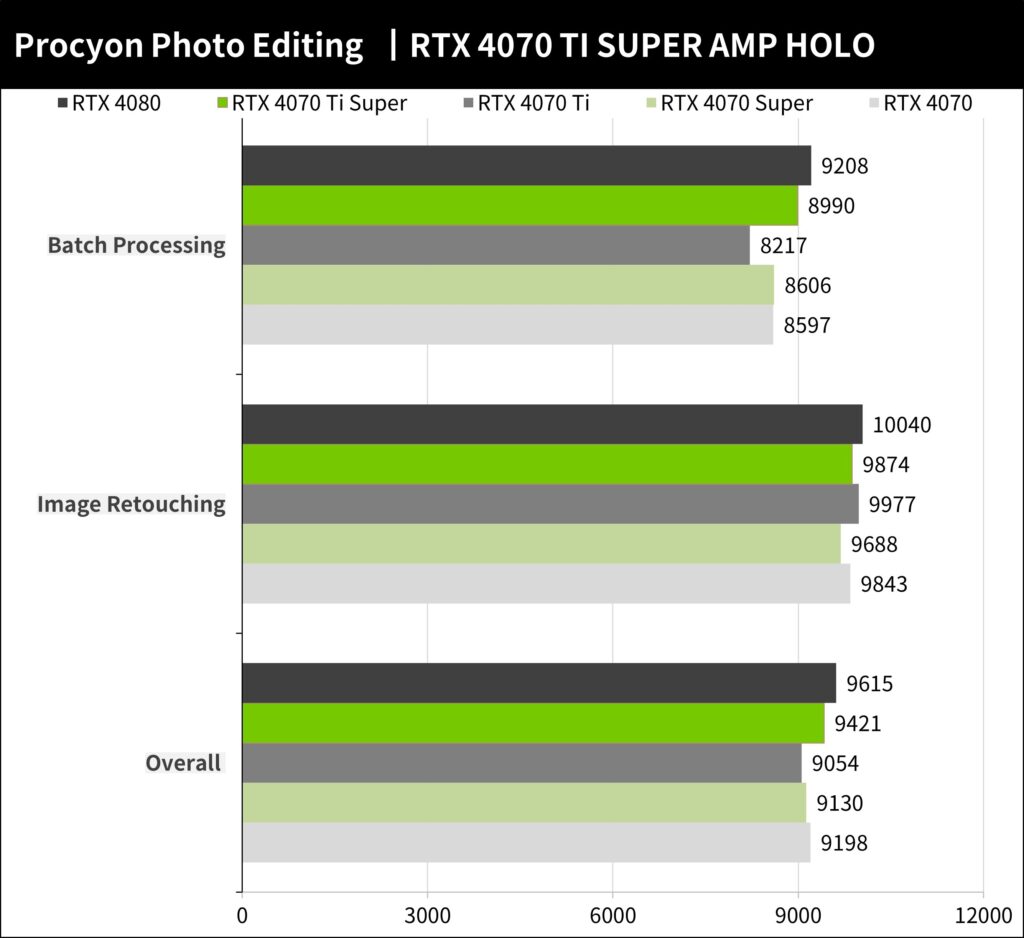
A bar graph with results from the UL Procyon Photo Editing Benchmark. This benchmark assesses performance in photo editing tasks using software like Adobe Photoshop and Lightroom Classic. The higher the score, the better the performance.
From the graph, we can see the following scores for each GPU:
- RTX 4080:
- Overall: 9615
- Image Retouching: 10040
- Batch Processing: 9208
- RTX 4070 Ti Super:
- Overall: 9421
- Image Retouching: 9874
- Batch Processing: 8990
- RTX 4070 Ti:
- Overall: 9130
- Image Retouching: 9977
- Batch Processing: 8217
- RTX 4070 Super:
- Overall: 9054
- Image Retouching: 9688
- Batch Processing: 8606
- RTX 4070:
- Overall: 9198
- Image Retouching: 9843
- Batch Processing: 8597
These results provide a clear comparison between the different graphics cards in the RTX 4070 series, including the Super variants, and the RTX 4080. The RTX 4070 Ti Super performs notably well, closely approaching the RTX 4080’s scores, and surpassing the other cards in overall performance. This information is valuable for users who are considering the trade-offs between price and performance when selecting a graphics card for photo editing work.
The PugetBench for DaVinci Resolve is a comprehensive benchmarking tool for evaluating a computer’s performance in video editing and color grading within DaVinci Resolve. The benchmark tests various aspects of performance, including playback and rendering speed with different media types and resolutions, as well as the GPU’s ability to handle compute-intensive tasks such as OpenFX and Fusion effects.
Here’s a breakdown of the performance of the RTX 4070 Ti Super based on the provided scores:
- Overall Score: 3327
- 4K Media Score: 226
- GPU Effects Score: 117
- Fusion Score: 601
These scores suggest that the RTX 4070 Ti Super performs exceptionally well in a video editing and effects rendering context. The card shows a 10% improvement over the RTX 4070 Ti, which is a significant margin, especially for professionals for whom time and efficiency are critical.
Furthermore, the RTX 4070 Ti Super is only 2% behind the RTX 4080 in this benchmark, indicating that it offers near top-tier performance, potentially at a better price-to-performance ratio. This information is particularly valuable for content creators who specialize in video editing and color grading and are considering upgrading to a new GPU. The RTX 4070 Ti Super seems to be a strong contender, offering robust performance in high-resolution video tasks.
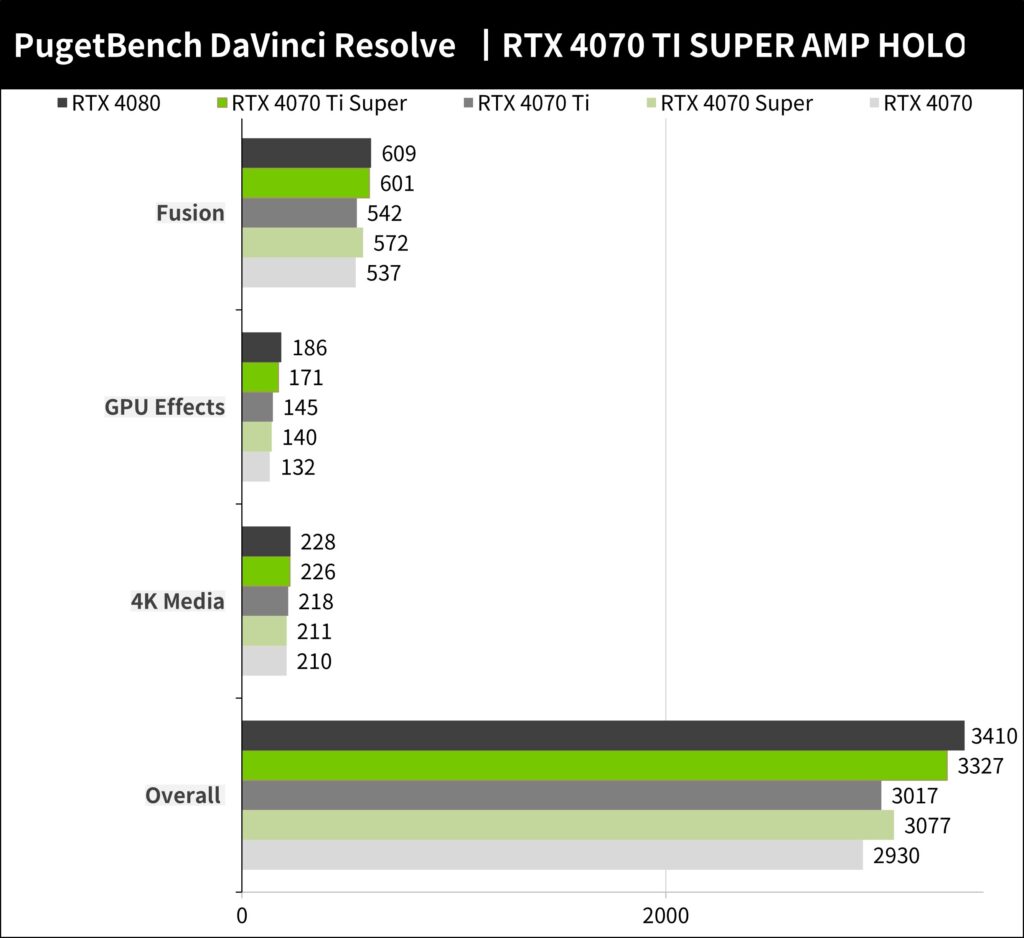
A bar chart depicting the scores from the PugetBench for DaVinci Resolve benchmark, comparing the performance of various NVIDIA RTX graphics cards. This benchmark measures the performance of video editing tasks in DaVinci Resolve, with a higher score indicating better performance.
From the chart, we can see the following scores:
- RTX 4080:
- Overall: 3410
- 4K Media: 228
- GPU Effects: 186
- Fusion: 609
- RTX 4070 Ti Super:
- Overall: 3327
- 4K Media: 226
- GPU Effects: 171
- Fusion: 601
- RTX 4070 Ti:
- Overall: 3017
- 4K Media: 218
- GPU Effects: 145
- Fusion: 542
- RTX 4070 Super:
- Overall: 3077
- 4K Media: 211
- GPU Effects: 140
- Fusion: 572
- RTX 4070:
- Overall: 2930
- 4K Media: 210
- GPU Effects: 132
- Fusion: 537
The RTX 4070 Ti Super demonstrates a strong performance across all the categories, particularly excelling in the Fusion category, which is demanding in terms of computing and graphical processing. It scores just under the RTX 4080 overall, indicating that it offers nearly comparable performance in a video editing context. This benchmark result suggests that the RTX 4070 Ti Super provides excellent performance for creative professionals working with 4K and 8K media in DaVinci Resolve, delivering robust GPU effects processing and efficient handling of complex tasks in Fusion.
The V-Ray Benchmark referencing is a performance measurement tool developed by Chaos Group. V-Ray is a rendering software that utilizes physical laws to simulate realistic lighting and materials in 3D environments. The benchmark can test both CPU and GPU capabilities specifically for ray tracing rendering tasks, which are computationally intensive and can give a good indication of the hardware’s prowess in such workloads.
Here are the scores for the RTX 4070 Ti Super:
- RTX Compute Score: 3537
- CUDA Compute Score: 2556
The RTX Compute score is likely reflective of the card’s ray tracing capabilities, which utilize the RT cores in the GPU. The CUDA Compute score represents the card’s general-purpose GPU compute performance, which is used for tasks that don’t necessarily leverage ray tracing but still require significant parallel processing power.
According to the data, the RTX 4070 Ti Super shows an average performance increase of 16% over the RTX 4070 Ti, which is a substantial improvement and indicates significant gains in efficiency or power. Furthermore, the RTX 4070 Ti Super’s performance is only 10% lower than the RTX 4080. This smaller gap in performance between the RTX 4070 Ti Super and the RTX 4080 suggests that the RTX 4070 Ti Super offers strong performance that approaches that of the higher-tier card, potentially making it a more cost-effective option for users who need powerful GPU rendering capabilities for applications like V-Ray.
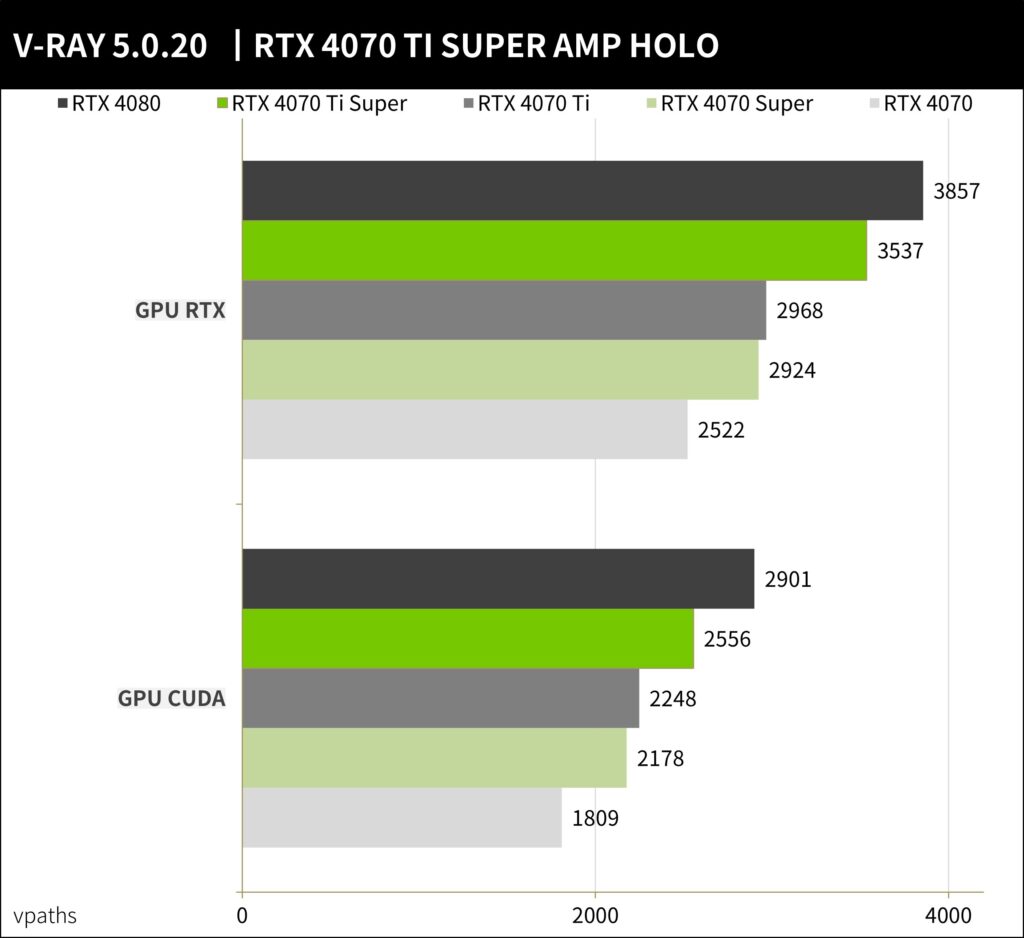
A bar chart from the V-Ray Benchmark displays the scores for the GPU RTX and GPU CUDA tests across various models in the NVIDIA RTX 4070 series, including the RTX 4070 Ti SUPER AMP HOLO. This benchmark evaluates the rendering performance of GPUs using V-Ray, a widely used rendering software in the CG industry.
In the GPU RTX category, which likely tests the ray tracing capabilities of the GPUs, the RTX 4070 Ti Super achieves a score of 3537. In the GPU CUDA category, testing general compute performance, it scores 2556.
Here’s how the RTX 4070 Ti Super compares to other models:
- RTX 4080:
- GPU RTX: 3857
- GPU CUDA: 2901
- RTX 4070 Ti Super:
- GPU RTX: 3537
- GPU CUDA: 2556
- RTX 4070 Ti:
- GPU RTX: 2968
- GPU CUDA: 2248
- RTX 4070 Super:
- GPU RTX: 2924
- GPU CUDA: 2178
- RTX 4070:
- GPU RTX: 2522
- GPU CUDA: 1809
The chart indicates that the RTX 4070 Ti Super provides a significant performance uplift over the standard RTX 4070 Ti and even more so over the RTX 4070. It also shows that the RTX 4070 Ti Super’s performance is quite close to that of the RTX 4080, with only a 10% lower score in the GPU RTX test and around a 12% lower score in the GPU CUDA test, which demonstrates its high efficiency and capability in rendering tasks.
These results would be beneficial for professionals in the visual effects and 3D rendering industries who are looking for a powerful GPU that can handle intensive rendering workloads effectively. The RTX 4070 Ti Super emerges as a strong contender, offering high performance that edges close to the more expensive RTX 4080, making it a potentially more cost-effective choice for rendering workloads.
Blender is indeed a comprehensive, open-source 3D creation suite that supports the entirety of the 3D pipeline. Professionals and hobbyists use it for modeling, rigging, animation, simulation, rendering, compositing, and motion tracking, among others.
Benchmarking performance in Blender is an excellent way to gauge how well a GPU will handle 3D tasks. The Blender Benchmark tool provides a standardized set of demo projects to render, which gives a measure of how fast and efficiently a GPU can process complex 3D scenes.
According to the results:
- The RTX 4070 Ti Super shows a 12% increase in rendering performance over the RTX 4070 Ti.
- The RTX 4070 Ti Super performs 13% lower than the RTX 4080 in the same benchmark.
These percentages reflect the RTX 4070 Ti Super’s position in the market: it’s a powerful GPU that significantly improves upon its predecessor, the RTX 4070 Ti, offering better performance for rendering tasks in Blender, which can be particularly beneficial for time-intensive operations like animation and high-detail 3D modeling.
However, the RTX 4080 still outperforms it, as expected from a higher-tier card. For users who are making a decision on which card to purchase, these performance metrics suggest that the RTX 4070 Ti Super could be a strong middle-ground option, offering high performance at potentially a lower price point than the RTX 4080. This makes it an appealing choice for 3D artists and creators who require robust performance but must also consider budget constraints.
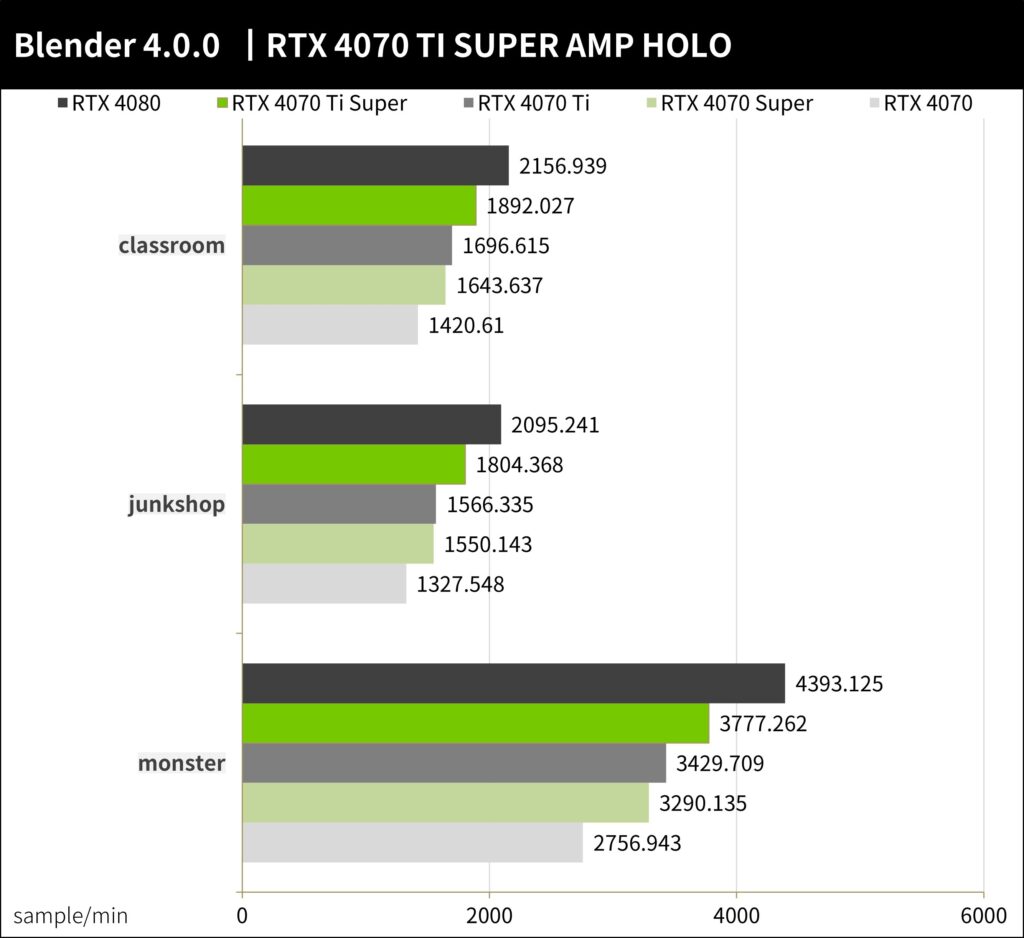
A bar chart from the Blender Benchmark 4.0.0, showing the performance of different NVIDIA RTX series graphics cards in rendering tasks. In Blender benchmarks, a higher score, which represents more samples per minute, indicates better performance.
Here’s a summary of the results:
- For the “classroom” scene:
- RTX 4080 leads with 2156.939 samples/min
- RTX 4070 Ti Super follows with 1892.027 samples/min
- For the “junkshop” scene:
- RTX 4080 again leads with 2095.241 samples/min
- RTX 4070 Ti Super scores 1804.368 samples/min
- For the “monster” scene:
- RTX 4080 significantly outperforms with 4393.125 samples/min
- RTX 4070 Ti Super has a score of 3777.262 samples/min
The RTX 4070 Ti Super’s performance is consistently robust across all the scenes, marking it as a strong GPU for 3D rendering tasks. It shows a solid lead over the RTX 4070 Ti and the RTX 4070 Super and is closely trailing behind the more powerful RTX 4080. These results would be especially interesting to 3D artists and render farms looking for high performance in Blender rendering, as they indicate the RTX 4070 Ti Super is capable of delivering near top-tier performance levels.
CINEBENCH has released a new version in 2024, which now utilizes the Redshift rendering engine by default. This engine is based on Cinema 4D, a leading 3D modeling, animation, and rendering application. This update signifies a major shift, as Redshift is known for its powerful GPU rendering capabilities, and the inclusion of comprehensive GPU and CPU tests allow for a cross-platform performance comparison, which could significantly enhance the benchmarking of CPU rendering capabilities as well.
The RTX 4070 Ti Super’s performance in this updated CINEBENCH benchmark is quite remarkable. Scoring 24,716 points places it in the same league as the RTX 4080 and shows a substantial 29% performance increase over the RTX 4070 Ti. This performance leap is attributed to the upgraded core of the RTX 4070 Ti Super to the AD103 and the increased memory capacity to 16GB of GDDR6X. Such improvements directly contribute to the card’s enhanced capabilities in GPU computation and rendering tasks.
For professionals and enthusiasts in fields that demand high-end rendering performance, such as CGI and visual effects, the RTX 4070 Ti Super appears to offer a significant value proposition. It delivers top-tier performance that is close to the more expensive RTX 4080, making it a potentially more cost-effective solution for intensive 3D rendering workloads.
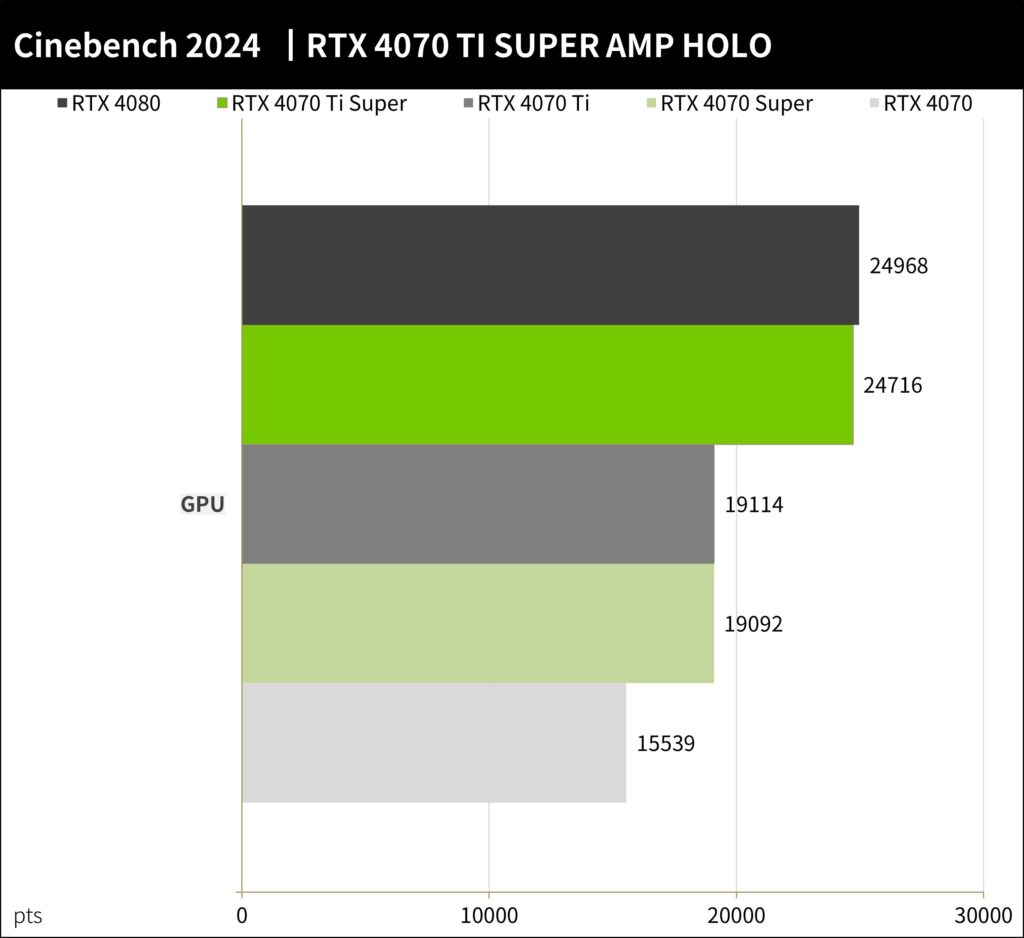
The bar chart results from the CINEBENCH 2024 benchmark, which compares the GPU performance of several NVIDIA RTX series graphics cards. In this benchmark, a higher score is better, indicating more efficient rendering performance.
The scores are as follows:
- RTX 4080: 24968 points
- RTX 4070 Ti Super: 24716 points
- RTX 4070 Ti: 19114 points
- RTX 4070 Super: 19092 points
- RTX 4070: 15539 points
The RTX 4070 Ti Super’s score is very close to that of the RTX 4080, showcasing that its performance is nearly on par with the higher-tier card. The substantial lead it has over the RTX 4070 Ti and other cards in the 4070 series indicates that the RTX 4070 Ti Super offers excellent performance for GPU rendering tasks in CINEBENCH, reflecting the improvements made with the AD103 core and the increased GDDR6X memory capacity. This performance level makes it a strong contender for professionals seeking powerful rendering capabilities without stepping up to the more expensive RTX 4080.
RTX 4070 Ti Super Shines in Stable Diffusion AI Model Test with TensorRT Boost
Stable Diffusion is an AI model capable of generating images from textual descriptions through deep learning techniques. The version referred to here, likely released by Automatic1111, suggests a community or a developer who has built an accessible implementation of the model, which may include certain enhancements or optimizations for ease of use or performance improvements.
TensorRT is an SDK for high-performance deep learning inference provided by NVIDIA, which includes a deep learning inference optimizer and runtime that delivers low latency and high throughput for deep learning inference applications. By integrating TensorRT, the performance of Stable Diffusion can be significantly accelerated on NVIDIA GPUs. This optimization allows for more efficient processing, making the generation of images from text quicker and potentially at a higher quality due to the ability to utilize more complex models or run more iterations in a given amount of time.
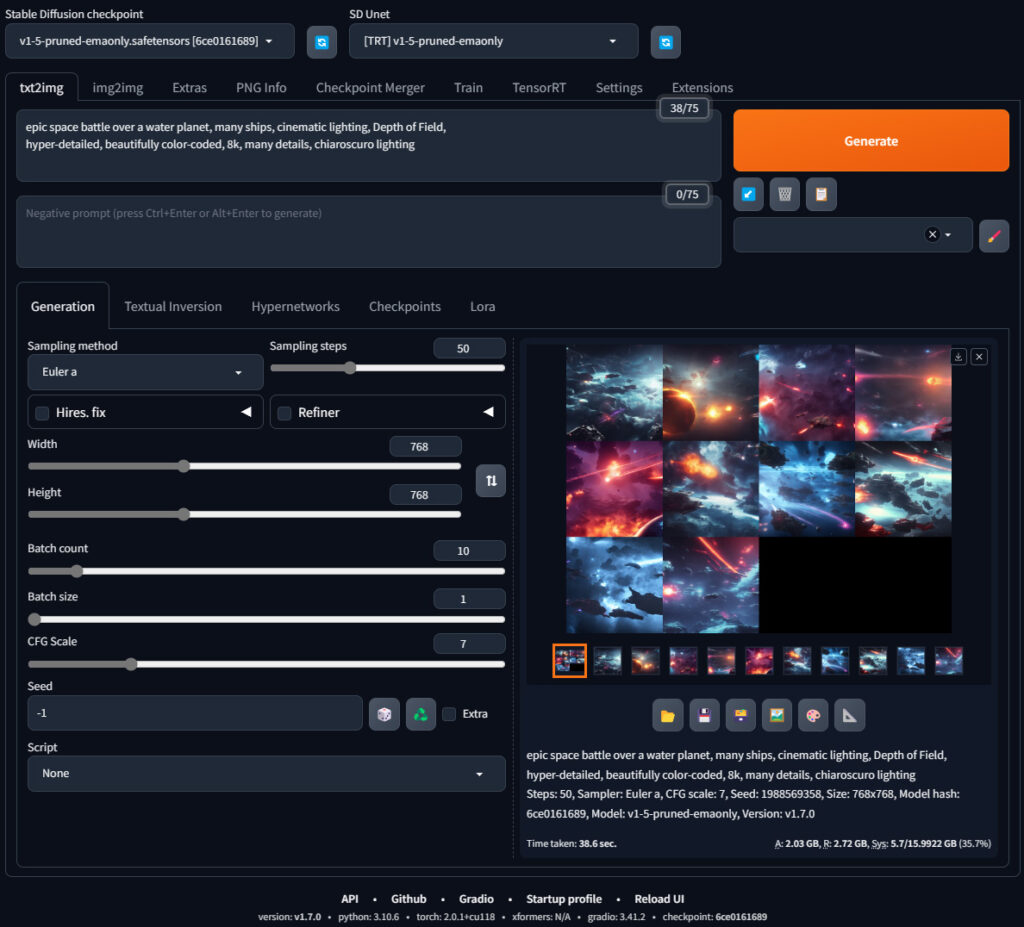
The Stable Diffusion WebUI interface is a user-friendly platform for interacting with the Stable Diffusion AI model. This interface simplifies the process of generating images from text prompts by allowing users to input their desired parameters and prompts through a graphical user interface rather than command-line tools.
From what can be seen in the screenshot, the user can select a variety of options to fine-tune the image generation process:
- Sampling method: This allows the user to choose the mathematical approach for the sampling process, which can affect the quality and characteristics of the generated image.
- Sampling steps: This refers to the number of steps the model takes during the generation process, which can impact the detail and coherence of the resulting image.
- Width & Height: The dimensions of the generated image can be specified here.
- Batch count: This is likely the number of images to generate in one go.
- Batch size: This may refer to the number of images generated per batch.
- CFG Scale: This scale can adjust the adherence to the text prompt; a higher value usually leads to an image more closely matching the prompt.
- Seed: This is used for the random number generator that influences the variability of the generated images. Using the same seed can produce the same image again, ensuring reproducibility.
The prompt given for the AI to generate images from is an “epic space battle over a water planet, many ships, cinematic lighting, Depth of Field, hyper-detailed, beautifully color-coded, 8k, many details, chiaroscuro lighting,” which would result in a detailed and dynamic space-themed image.
The bottom of the interface shows a log of the generation task, including the model version, the size of the model (which is a pruned version, likely for efficiency), and other details like the time taken to generate the images and the GPU memory used.
This setup indicates that the user is leveraging a powerful model with optimizations such as TensorRT for enhanced GPU performance, which is evidenced by the large-scale and complex images being generated in a relatively short amount of time. The interface appears to be well-suited for artists, designers, and hobbyists who are interested in exploring AI-generated art without needing to delve into the technicalities of command-line operations or machine-learning frameworks.
The performance metrics provided illustrate a significant advantage in using TensorRT optimizations with the RTX 4070 Ti Super for running the Stable Diffusion model. With TensorRT, the RTX 4070 Ti Super achieves a generation speed of 15.54 images per minute, which is a substantial 148% increase over the 6.28 images per minute performance of the standard Automatic1111 version without TensorRT optimizations.
In comparison to the RTX 4070 Ti, the RTX 4070 Ti Super’s performance with TensorRT optimizations shows an 8% improvement. Moreover, the RTX 4070 Ti Super’s performance is only 8% behind that of the RTX 4080 when using TensorRT, which is impressive considering the RTX 4080 is a higher-tier and presumably more expensive GPU.
These results highlight the impact of GPU acceleration and optimization technologies like TensorRT on AI-driven tasks. By optimizing the model inference with TensorRT, users can experience significantly faster performance, which can be particularly beneficial for workflows that require generating a large volume of images, such as in content creation, game development, or data augmentation for machine learning training sets.
The RTX 4070 Ti Super, with its TensorRT optimizations, provides a near top-tier performance that might offer a more favorable cost-to-performance ratio for professionals and enthusiasts working on AI image generation projects.
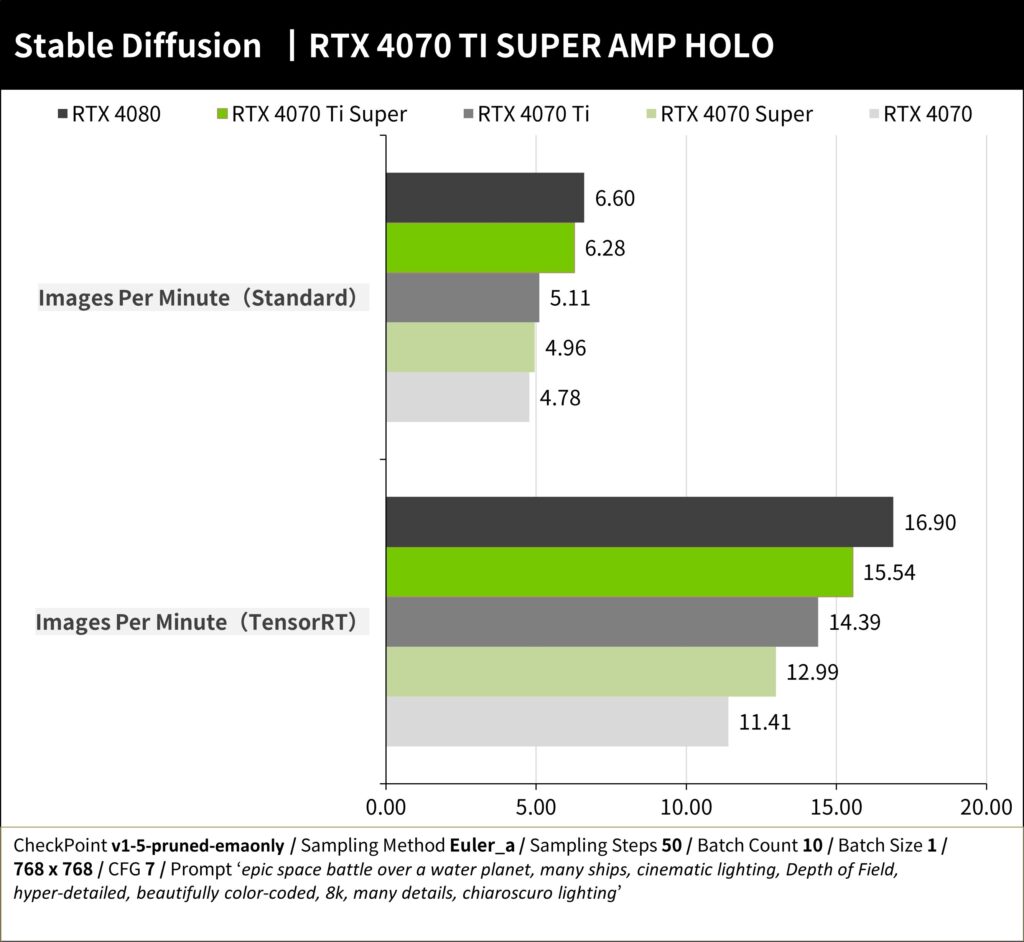
The bar chart provided illustrates the image generation performance of various NVIDIA graphics cards using the Stable Diffusion model, both with standard settings and with TensorRT optimization. The chart indicates the number of images generated per minute, with a higher number indicating better performance.
Here’s a brief overview of the performance metrics displayed:
- In the standard configuration (without TensorRT), the RTX 4070 Ti Super generates 6.28 images per minute.
- With TensorRT optimization, the RTX 4070 Ti Super’s performance more than doubles, achieving 15.54 images per minute.
- The RTX 4080 tops the chart with 16.90 images per minute with TensorRT, which is only marginally higher than the RTX 4070 Ti Super.
- Other cards like the RTX 4070 Ti and RTX 4070 Supershow significantly lower performance compared to the RTX 4070 Ti Super with TensorRT.
The results underscore the effectiveness of TensorRT in boosting the performance of AI models on NVIDIA GPUs, particularly for the Stable Diffusion image generation task. The RTX 4070 Ti Super, with TensorRT, offers near top-end performance, making it an attractive option for those who need high-speed image generation capabilities without the highest price tag. This data is crucial for users who may be deciding on a GPU purchase and are considering the balance between cost and performance for AI-driven tasks.
RTX 4070 Ti Super Excels in 3DMark Benchmarks: Dominates in Fire Strike, Time Spy, and Ray Tracing Tests
The 3DMark Fire Strike benchmark is a widely recognized standard for testing the performance of GPUs under DirectX 11 API at different resolutions. The scores mentioned for the RTX 4070 Ti Super are as follows:
- Fire Strike (1080p): 53,369 points
- Fire Strike Extreme (1440p): 29,377 points
- Fire Strike Ultra (2160p): 14,484 points
Compared to the RTX 4070 Ti, the RTX 4070 Ti Super shows an average performance increase of 7%, which is a notable improvement within the same generation of cards. This suggests that the RTX 4070 Ti Super is well-suited for high-definition gaming at 1080p and 1440p resolutions, with respectable performance even at 4K resolution.
The RTX 4070 Ti Super’s performance being slightly below the RTX 4080 by approximately 12% aligns with expectations, given the positioning of the RTX 4080 as a higher-tier GPU. For gamers and professionals looking for a GPU that can handle demanding graphics workloads without going for the highest-end option, the RTX 4070 Ti Super presents a strong case with its balance of price and performance.
These results would be particularly useful for consumers looking to upgrade their gaming or content creation setups, as they provide a clear picture of the relative capabilities of these GPUs in terms of gaming performance at various resolutions.
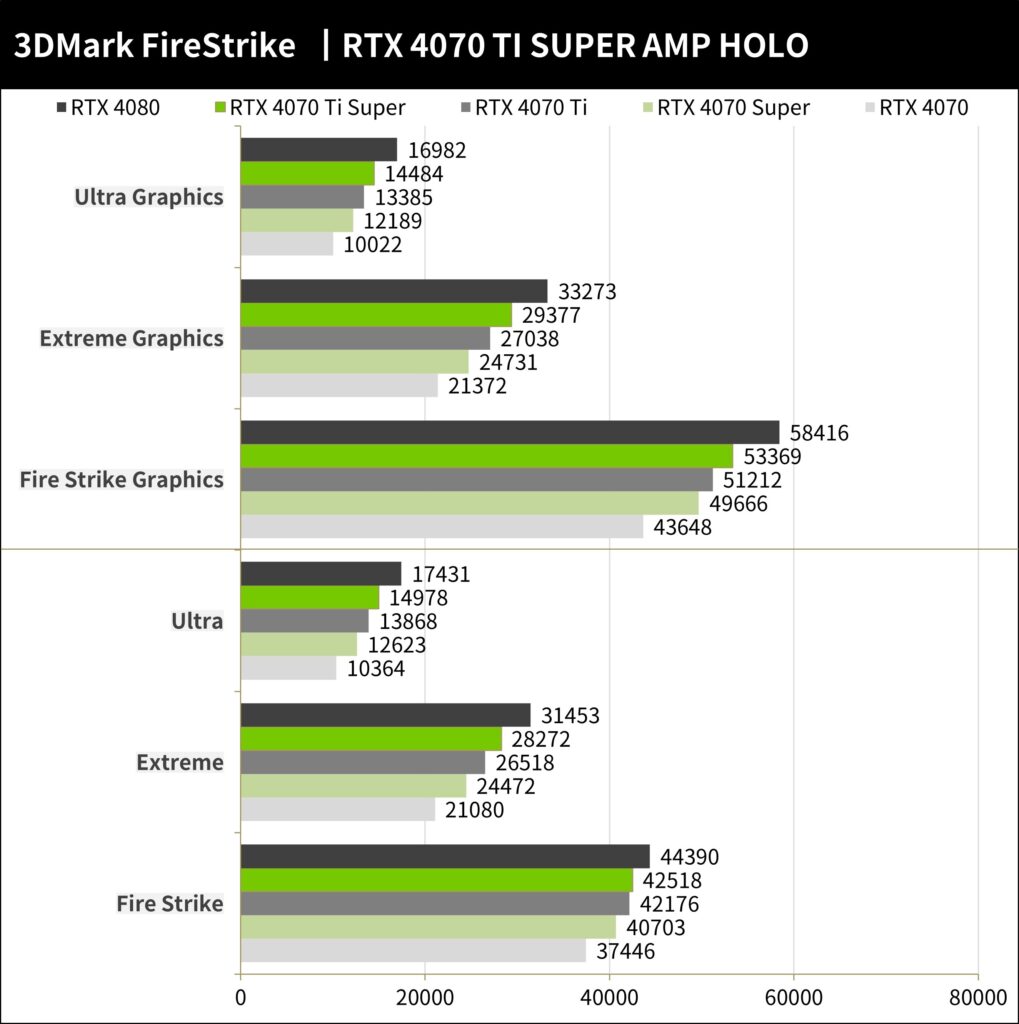
The bar chart provided details of the scores for various NVIDIA graphics cards in the 3DMark Fire Strike benchmark, a popular tool for measuring the performance of graphics cards under gaming-like scenarios using DirectX 11.
Here’s a brief summary of the data from the chart:
- Fire Strike Graphics (1080p)
- The RTX 4070 Ti Super scores 53,369 points, which is a strong performance, especially compared to the base RTX 4070’s score of 43,648 points.
- Extreme Graphics (1440p)
- The RTX 4070 Ti Super scores 29,377 points, showcasing its capability at higher resolutions and more demanding rendering tasks.
- Ultra Graphics (2160p)
- The RTX 4070 Ti Super scores 14,484 points, demonstrating that it can handle 4K gaming, though with an expected drop in score due to the increased demand for 4K rendering.
In comparison to the RTX 4080, the RTX 4070 Ti Super’s performance is lower but still competitive, particularly considering the likely cost difference between the two cards. The RTX 4070 Ti Super shows a clear performance advantage over the non-Super RTX 4070 Ti, making it a potentially attractive option for gamers looking for high performance without reaching top-tier pricing.
This data is valuable for consumers in the market for a new GPU, as it provides a clear comparison of performance across NVIDIA’s product line, helping buyers make informed decisions based on their specific needs and budget considerations.
The 3DMark Time Spy benchmark is designed to assess the performance of graphics cards using the DirectX 12 API, which is the modern standard for next-generation gaming and high-fidelity AAA game titles. It provides a measure of GPU performance at 1440p resolution in its standard test and 2160p (4K) resolution in its Extreme version.
Based on the results shared:
- The RTX 4070 Ti Super achieves a score of 24,617 in the standard Time Spy (1440p) graphics test.
- In the Time Spy Extreme (2160p) graphics test, it scores 12,170.
These scores represent an 8% increase in performance over the RTX 4070 Ti, signifying that the RTX 4070 Ti Super is a more powerful variant within the same product tier, with a noticeable improvement in high-resolution gaming scenarios.
However, compared to the RTX 4080, the RTX 4070 Ti Super performs approximately 13% lower. This performance gap is consistent with the positioning of the RTX 4080 as a more premium option, typically offering higher frame rates and better rendering quality for demanding gaming and content creation tasks.
For users looking for a high-performance graphics card that can handle intensive gaming and creative workloads, especially at higher resolutions, the RTX 4070 Ti Super emerges as a strong contender. It offers considerable power for its class while presumably coming at a lower price point than the RTX 4080, giving users a balance between performance and cost.
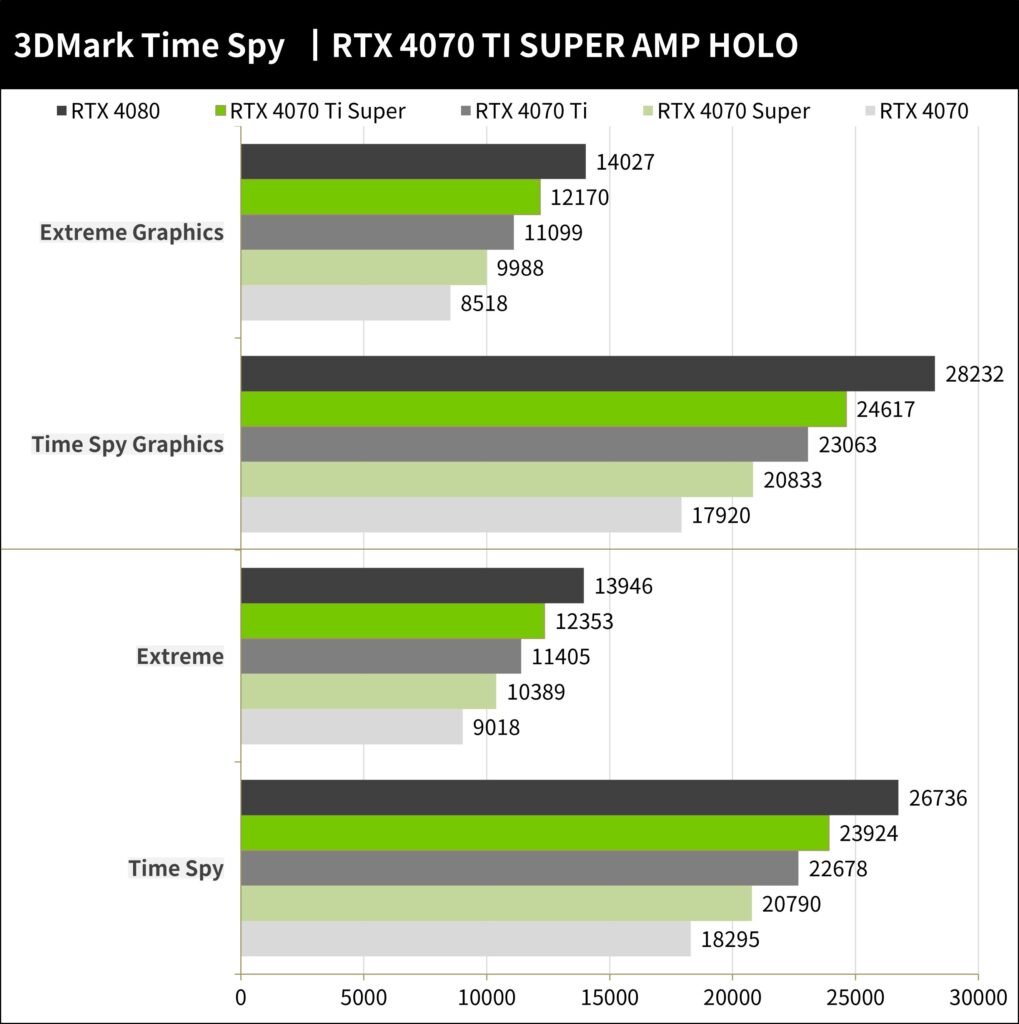
The provided bar chart from the 3DMark Time Spy benchmark results showcases the performance of different NVIDIA graphics cards. The RTX 4070 Ti Super shows robust results in both the Time Spy and Extreme versions of the benchmark:
- Time Spy (1440p): The RTX 4070 Ti Super scores 24,617 points, indicating strong performance at this resolution.
- Time Spy Extreme (2160p): With a score of 12,170 points, the RTX 4070 Ti Super demonstrates its capability to handle the more demanding 4K resolution.
The RTX 4070 Ti Super’s performance is an improvement over the RTX 4070 Ti, with an 8% increase in the standard Time Spy test and similar gains in the Extreme test. Although the RTX 4070 Ti Super trails the RTX 4080 by about 13%, it still offers commendable performance, especially considering the likely differences in price between the two models.
These results would be particularly informative for gamers and content creators who require a high-performance GPU that can deliver quality and speed for 1440p and 4K gaming, without the top-tier cost associated with the highest-end GPUs. The RTX 4070 Ti Super appears to strike a balance between price and performance, making it a valuable option for high-end users who are budget-conscious.
The 3DMark suite includes several tests that specifically focus on the performance of ray tracing, which is a rendering technique for generating an image by tracing the path of light and simulating its interactions with virtual objects. This technology is central to achieving realistic lighting effects in modern AAA games. The results provided for the RTX 4070 Ti Super indicate the following:
- Port Royal: 73.65 frames per second (FPS)
- DXR Test: 73.54 FPS
- Speed Way: 64.67 FPS
These results, achieved without the use of DLSS (Deep Learning Super Sampling), suggest that the RTX 4070 Ti Super has an 11% improvement in ray tracing performance over the RTX 4070 Ti, which indicates significant enhancements in its architecture or clock speeds that contribute to better handling of ray-traced graphics.
However, the RTX 4070 Ti Super is still approximately 12% behind the RTX 4080 in ray tracing performance. This gap is likely due to the RTX 4080’s higher-tier capabilities, possibly including more RT cores, which are specialized for ray tracing computations.
For consumers, these performance metrics are essential to consider if they are interested in gaming with ray tracing enabled. While the RTX 4070 Ti Super may not match the highest-end RTX 4080, it still offers high-quality ray-tracing performance, making it suitable for gamers who want to enjoy ray-traced graphics without paying the premium price for the top-of-the-line model. The balance between cost and ray tracing capability makes the RTX 4070 Ti Super an attractive option for gaming enthusiasts who prioritize visual fidelity.
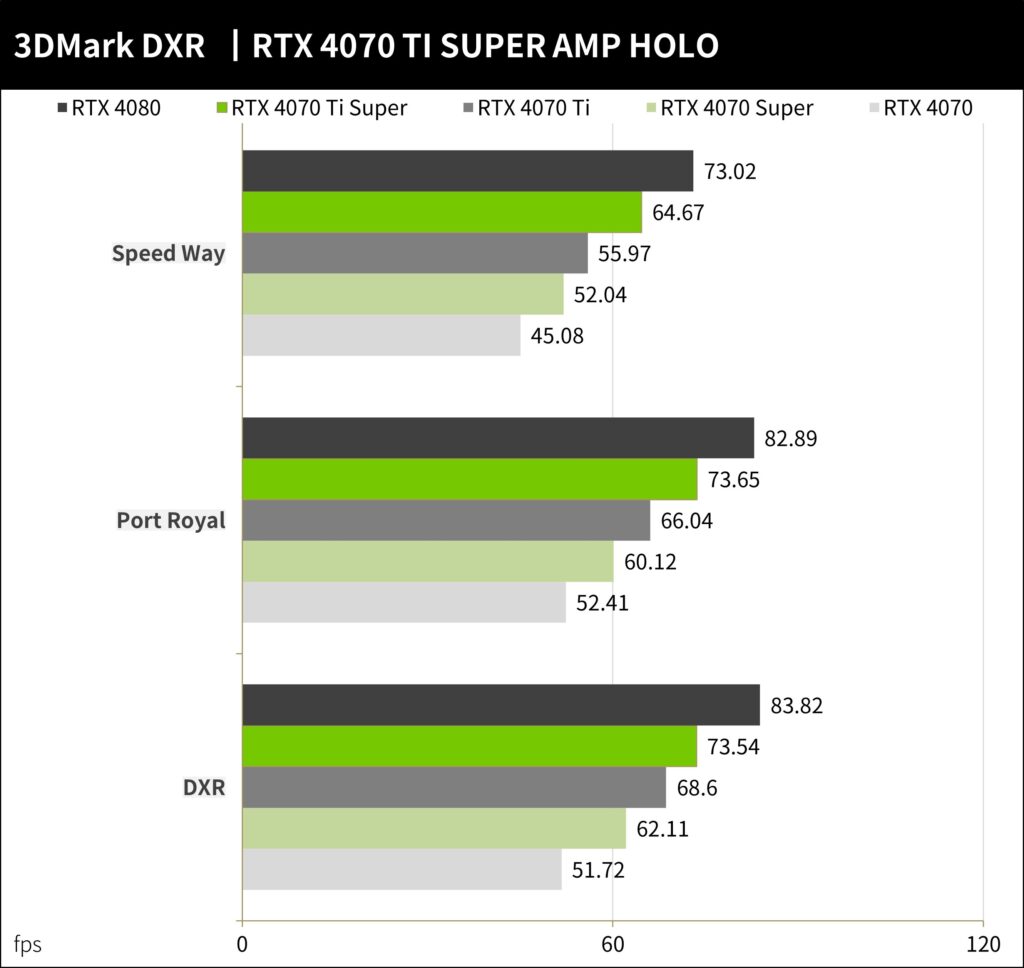
The 3DMark DXR (DirectX Raytracing) benchmarks displayed in the image focus on the performance of ray tracing, which is an advanced rendering technique that creates realistic lighting effects by simulating the physical behavior of light. The higher the frame rate (FPS), the better the performance of the GPU in handling ray-tracing tasks.
The results show that the NVIDIA GeForce RTX 4070 Ti Super offers impressive ray tracing performance in the 3DMark benchmarks, with the following frame rates:
- Speed Way: 64.67 FPS
- Port Royal: 73.65 FPS
- DXR: 73.54 FPS
These benchmarks are particularly demanding as they are designed to push the limits of ray tracing technology in GPUs. The RTX 4070 Ti Super’s performance is quite close to the RTX 4080, which is a more powerful and likely more expensive GPU. This suggests that the RTX 4070 Ti Super provides good value for gamers who want to experience ray tracing in their games without the top-tier cost. It’s a strong contender for those looking to build a high-performance gaming system with the capability of rendering advanced graphics features.
The 3DMark DLSS Feature Test measures the performance uplift provided by NVIDIA’s Deep Learning Super Sampling (DLSS) technology, which uses AI to upscale images in real time, allowing for higher frame rates without significantly compromising image quality.
The results for the NVIDIA GeForce RTX 4070 Ti Super in the DLSS 2 and DLSS 3 tests at a 4K resolution (3840 x 2160) under the Performance setting are as follows:
- DLSS 2: 90.11 FPS, which is approximately a 2.67 times performance increase compared to native rendering without DLSS.
- DLSS 3: 116.83 FPS, which is about a 3.4 times performance boost, leveraging AI frame generation techniques to provide even smoother gameplay.
DLSS 3, which includes AI frame generation, further enhances performance over DLSS 2 by predicting and generating intermediate frames. This allows the RTX 4070 Ti Super to deliver much higher frame rates for a smoother and more immersive gaming experience, especially at 4K resolution where the GPU workload is typically much more demanding. This feature is particularly beneficial for gamers who want to enjoy detailed graphics settings and high resolutions without sacrificing frame rates.
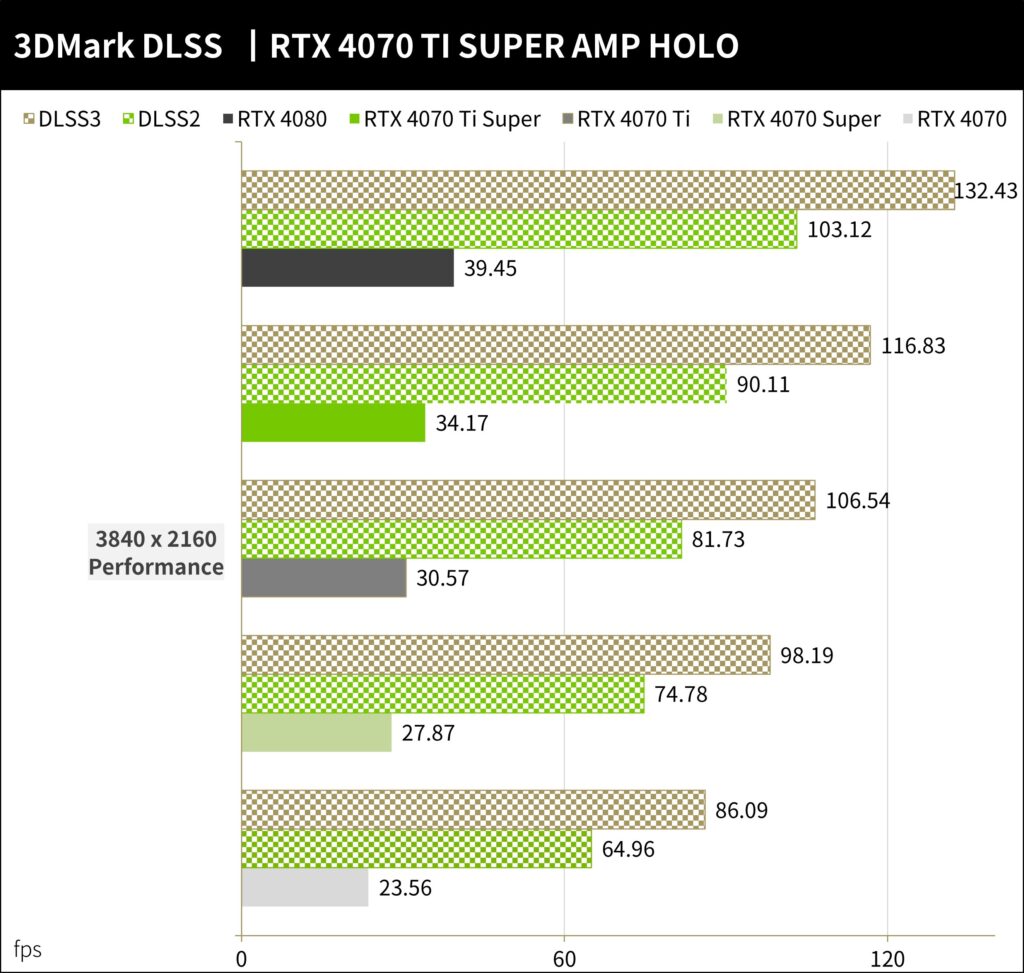
The 3DMark DLSS Feature Test results for the RTX 4070 Ti Super AMP Holo are presented, showing the performance difference between DLSS 2 and DLSS 3 at a 4K resolution with Performance mode enabled. The graph illustrates how the DLSS technology significantly boosts frame rates, with DLSS 3 providing an even greater increase than DLSS 2, highlighting the advancements in NVIDIA’s AI-driven graphics enhancement features. Higher frames per second (fps) indicate smoother and more responsive gameplay.
RTX 4070 Ti Super: A Powerhouse for 1440p and 2160p Esports Gaming
For competitive gaming, the performance of the RTX 4070 Ti Super seems to be more than adequate for both 1440p and 2160p resolutions. The tests, which were conducted at the highest settings, showed that for tactical team-based shooters and MOBA-type games such as “Rainbow Six: Siege,” “League of Legends,” “Apex Legends,” and “Counter-Strike 2,” where high frame rates are crucial and graphical fidelity is not the primary concern, the RTX 4070 Ti Super delivers an average of over 100 FPS. When compared to the RTX 4070 Ti, the RTX 4070 Ti Super offers a 4-8% increase in performance, though it still performs around 5% lower than the RTX 4080.
RTX 4070 Ti Super Masters AAA Gaming: Dominates at 1440p and 2160p in Extensive Tests
The RTX 4070 Ti Super has been tested across nine AAA games at 1440p and 2160p resolutions with all settings maxed out. The only game that used ray tracing was “F1® 22,” while the others were tested without ray tracing or DLSS to assess the GPU’s traditional rendering performance.
The gaming test lineup included the newly added “Diablo IV” and “Avatar: Frontiers of Pandora,” as well as staples like “F1® 22,” “Shadow of the Tomb Raider,” “Horizon: Zero Dawn,” and more demanding titles like “Borderlands 3,” “Assassin’s Creed: Valhalla,” “Red Dead Redemption 2,” and “God of War.”
At 1440p resolution, the RTX 4070 Ti Super achieved an average of 153.54 FPS across these AAA titles, which is approximately an 11% performance increase over the RTX 4070 Ti’s average of 138.02 FPS, and around 10% lower than the RTX 4080’s average of 171.17 FPS.
For 2160p resolution, the RTX 4070 Ti Super averaged 90.57 FPS, which is a 14% performance increase over the RTX 4070 Ti’s average of 79.37 FPS, and similarly, around 10% lower than the RTX 4080’s average of 100.63 FPS.
This indicates that the RTX 4070 Ti Super offers solid performance, capable of satisfying the demands for 4K 60 FPS gaming. If these tests were paired with DLSS, it could potentially deliver an even more stable and smooth high-resolution gaming experience.
RTX 4070 Ti Super Shines in Ray Tracing: Stellar Performance in Top DXR Games at 1440p and 2160p
The RTX 4070 Ti Super was tested with eight ray tracing (DXR) games, including the Game of the Year “The Witcher 3: Wild Hunt,” as well as “Hogwarts Legacy,” the NVIDIA-modified “Portal with RTX” ray tracing version, and other titles like “Cyberpunk 2077,” “Control,” “Spider-Man: Miles Morales,” “Marvel’s Guardians of the Galaxy,” and “Far Cry 6.” The tests were conducted at 1440p and 2160p resolutions with the highest settings for effects and ray tracing, and DLSS was enabled to enhance performance. Detailed settings can be referred to in the accompanying chart.
At 1440p resolution with DLSS 3 enabled, the RTX 4070 Ti Super delivered an impressive performance with an average of 143 FPS in “The Witcher 3: Wild Hunt,” 151 FPS in “Portal with RTX,” and 174.12 FPS in “Cyberpunk 2077.” The average for the eight ray tracing games reached 156.1 FPS.
Compared to the RTX 4070 Ti, which averaged 145.5 FPS at 1440p, the RTX 4070 Ti Super showed a 7% performance improvement in ray tracing games, while it was about 7% lower than the RTX 4080’s average of 167.2 FPS.
In the more demanding 2160p resolution, the RTX 4070 Ti Super averaged 98.4 FPS, which is a 13% performance improvement over the RTX 4070 Ti’s average of 86.6 FPS and about 8% lower than the RTX 4080’s average of 106.5 FPS. This demonstrates the RTX 4070 Ti Super’s solid ray tracing performance, even at high resolutions, especially when boosted with DLSS technology.
Efficiency Meets Performance: RTX 4070 Ti Super AMP HOLO’s Power and Temperature Benchmarks
For the power consumption and temperature tests of the graphics card, the Speed Way Stress test, Furmark, and “Cyberpunk 2077” were used. Power consumption was measured using NVIDIA’s PACT tool, which can monitor the wattage provided by the PCIe slot and the 12V power supply.
In terms of temperature, the RTX 4070 Ti Super AMP HOLO maintained a maximum temperature of 61.3°C during stress testing. During gameplay in “Cyberpunk 2077,” the temperature was slightly lower at around 60°C.
The Total Board Power (TBP) consumption of the graphics card was tested with the RTX 4070 Ti Super AMP HOLO averaging 290.2W during the Speed Way Stress test. In the Furmark 4K Xtreme burn-in test, the power consumption peaked at 292.5W. However, during gameplay in “Cyberpunk 2077,” the power consumption was only 266.6W. These results show that the RTX 4070 Ti Super AMP HOLO has a relatively high power demand but manages to keep temperatures within a reasonable range under load.
Summarize
In summary, the NVIDIA GeForce RTX 4070 Ti Super, equipped with an AD103 GPU, offers a 10% increase in core count and an expanded 16GB of GDDR6X memory while maintaining the same price point of USD 799, with a recommended starting price of NT$29,490 in Taiwan. It delivers smooth performance with an average of 153.54 FPS in 1440p AAA games and 156.1 FPS with ray tracing and DLSS accelerated games. Even at 2160p resolution, it manages an average performance of 90.57 FPS and 98.4 FPS.
In comparison, the RTX 4070 Ti Super shows an 11% performance increase in AAA games at 1440p and a 14% increase at 2160p over the RTX 4070 Ti. With ray tracing and DLSS accelerated games at 1440p, it shows a 7% increase, and at 2160p, a 13% increase. When compared to the RTX 4080, it falls behind by only about -10% in AAA games and -8% in ray tracing and DLSS accelerated performance.
Overall, the performance of the RTX 4070 Ti Super meets expectations. For players with a sufficient budget aiming for stable 4K60 gaming, the RTX 4070 Ti Super provides stable 4K gaming performance, satisfying the needs for next-generation ray tracing, AI computation, and DLSS acceleration. For those looking for cost-effectiveness, the currently price-adjusted RTX 4070 and RTX 4070 Ti are undeniably the best choices for excellent 2K gaming performance.
If this article is helpful for you, please share this article with your friends on social media. Thank you!
This article is based on the personality of the reviews. You are responsible for fact-checking if the contents are not facts or accurate.
Title: Introducing NVIDIA GeForce RTX 4070 Ti Super: The Ultimate 4K60 Gaming Powerhouse – Enhanced Core, 16GB GDDR6X, and Stellar Performance Close to RTX 4080